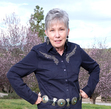Sandy Nathan's Blog, page 6
June 16, 2013
A Father’s Day Tribute to my Dad – Andy Oddstad
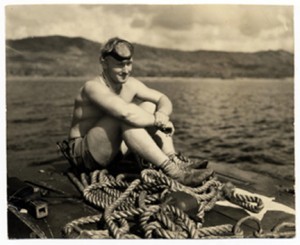
Andres Fjeldsted Oddstad in full battle gear. He was a "frogman" in the US Navy, part of an Underwater Demolition Team sent to occupied waters to clear bombs before the Marines arrived.
Today’s the day we remember our fathers. But don’t we remember them with every breath we take? They are multi-sensory reality templates: the way they look, move, sound, act, talk, walk, think, and even smell brands us to the bone. We can’t forget them: we are them. Aside from shaping my body, my father’s existence informs everything I do. I say my work-o-holism is from being born and raised in Silicon Valley. It’s really from my dad’s ceaseless activity.
This is one of my long articles. It contains a newspaper interview of my dad from the 1960s. I’m including it in toto as an expression of love and gratitude to a man I loved. It’s also a glimpse of the history of the San Francisco Bay Area before Silicon Valley existed. It’s a glimpse of a man raised in the Great Depression who rose from nothing. A smart man. In the post below, my dad discusses economics. I didn’t know he knew all this stuff. I majored in economics, but didn’t get to discuss it with him. He died before I could.
Was my father’s death the most traumatic thing that’s happened to me? No, but it set a record in 1964 when a drunk driver slammed into him head on. I didn’t know a man like Andy Oddstad could die: scholar, football player, war hero, super successful businessman, weight lifter, AAU champion wrestler, unbelievable water skier, supporter of all sorts of charities and causes, husband, dad, terrible horseman, and the center of my family’s life. How could he die?
Just like anyone else.
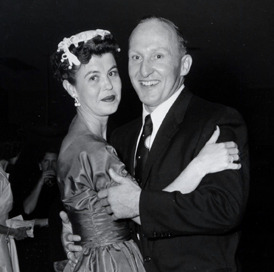
Andy & Clara Oddstad in the good days. My parents were a love story for the ages.
I was looking through old family albums recently and came upon the following article about my father. It contained information that I thought worth sharing––some of it was new to me. Father’s Day is a good time to acknowledge what he did.
For all his accomplishments, some of which are laid out below, my dad died at age 45. No, he didn’t die of a heart attack. He was in perfect health. Someone who turned the wrong way onto a freeway off-ramp killed him. The old guy might have been drunk––he did have an opened bottle of wine on the seat next to him–-or he might have been confused. He could have been trying to end his own life. He did end his life, along with my father’s.
Here’s the article from an old newspaper. I’m going to post it in its entirety.
From the DAILY COMMERCIAL NEWS, “OLDEST BUSINESS NEWSPAPER ON THE PACIFIC COAST––SINCE 1875,” Thursday, January 15, 1959, by Hugh Russell Fraser
Today’s Bay Area Profile of Andy Oddstad is another in a DAILY COMMERCIAL NEWS series which appears each Thursday to give you an intimate portrayal of prominent Bay Area executives. The author, Hugh Russell Fraser, is recognized as among the top book reviewers and biographical writers of our time. ––Editor.
When I heard that down in Redwood City there is a man, only 40 years old, who has built 10,000 houses in the Bay Area in the last 10 years, I decided to go down and see what he was like.
They call him Andy Oddstad, but his real name is Icelandic in origin––Andres Fjeldsted Oddstad.
He is a stocky, blond type, built like a wrestler (which he was at college, and still is), decidedly affable and friendly in his manner.
There is nothing ostentatious about his office a 1718 Broadway. There he presides over the destinies of 10 construction and building companies, the best known of which is Oddstad Homes.
With a signal to his secretary to cut off the phone, so as to give me his uninterrupted attention (How I hate these tycoons who take a dozen calls while pretending to talk to a visitor!), he talked in a low-pitched, well-modulated voice.
Naturally, I wanted to find out what made the man tick; I first questioned him about how he got into the home-building business.
Born in British Columbia, Oddstad’s forbearers were all from Iceland. He was 9 years old when his father, a carpenter and builder, moved to San Francisco. Here he worked for his brothers-in-law, the famous builders Ellis and Henry Stoneson. Young Andy went to Sunnyside Grammar School.
At the age of 10 he knew he was going into the building business. Never was there any doubt of it.
FASCINATED
Not because his uncles were builders in a big way, the founders of Stonestown, but because everything about building, from sweeping out the floors of new houses to constructing walls and roofs, fascinated him.
Every daylight hour that he did not have to spend in school, he spent around building projects; in fact, he worked after school cleaning up trash on building sites, sweeping floors, helping make repairs. He discovered he would rather do that than play.
Meanwhile, Andy kept on going to school––first to Aptos Junior High, then two years at San Francisco college and finally two years at the University of California [at Berkeley] from which he graduated with honors and an engineering degree in 1941.
Despite the financial status of his uncles, he worked his way through college, always in building and construction work.
It was while at college that he stumbled onto something that made him think of business in more precise terms. He took as his graduate thesis a study of low-cost housing in California!
ALMOST HALF
He went all over the state, and in San Diego he ran into an eye opener. Mind you, this was in 1941 when government construction of low-cost housing was at its high point. He discovered to his amazement that Uncle Sam was putting out $9000 for a unit that was little more than a three-room apartment, while in San Francisco, private enterprise was building five-room houses with a garage underneath, definitely superior to the San Diego Government-subsidized project, for about $4250! In other words, for less than half the subsidized amount!
That was his first acquaintance with the waste inherent in bureaucracy. He could hardly believe his eyes, but slowly he came to realize that he was looking at a simple and inescapable fact.
His interesting and carefully documented thesis went to waste, however, although the University of California gave him a pat on the back for it.
Hardly had he completed this study when the approach of World War II brought him into the Navy. There he became a “frogman,” an undersea demolition expert. He saw combat duty in Okinawa, winning a raft of medals, including the Bronze Star Medal, a Presidential Unit Citation, and the Pacific Theater Ribbon with five battle stars.
On getting out of the Navy, with the rank of Lieutenant [Actually, Ensign SN], he returned to the Bay Area. Then he decided to go into business for himself. [The initial business was funded with $500 or thereabouts that my mother, Clara Oddstad, saved from her wartime wages. SN] He teamed up with another Icelander, Chris Finson, who hailed from Seattle, and together they formed the Sterling Building Company.
GREAT TRIO
It was at this point that his famous uncles, Henry and Ellis Stoneson, came in with help and guidance. A third man, to whom Oddstad gives great credit, was Parker Maddux, one-time president of the San Francisco Bank. This great trio, all three of whom helped Andres Oddstad on the road to a spectacular success, have all passed on, Henry Stoneson only recently.
Andres Oddstad doesn’t think much of the co-called “self-made men” who insist they did it all, that nobody helped them.
“When you come to analyze it,” he said, “that is nonsense. Nobody makes it alone. Sooner or later, they get cooperation and/or assistance. I am proud of the help and expert guidance that I got from my uncles and from Parker Maddux, and if you writing anything about me, don’t forget to mention their names!”
I like this about the man. No boasting, no phony claims. In fact, I think he underestimated, rather than overestimated, his own ability, which I soon recognized was considerable. It is plain he is a hard and unremitting worker; that he thinks problems through and believes in doing a through and careful job.
But he also has imagination! This was apparent in his keen interest in economics and architecture. Perhaps a better word is enthusiasm, although I do not usually associated the word “enthusiasm” with a man who always talks in a low-pitched voice, never once raising it to an excited pitch.
It was obvious he has been fascinated by two men, the great architect, Frank Lloyd Wright, and J. Kenneth Galbraith, author of The Affluent Society. Wright he regards as a great architect, the like of which American has never known. “He thinks and designs in three dimensions,” says Oddstad. “In addition, he is a showman and super salesman. Take this training ground he operates for young architects on the desert near Phoenix, Arizona. [Taliesin West] There he takes young men out of college, puts them to work drafting––carrying out his ideas, and the result is he has a far-reaching influence on the rising generation of architects.
“Wright sees things in their relation to their environment. Many orthodox architects––and Wright is anything but orthodox––remind me of the fellow who polishes a pebble in a mosaic. Write has helped me think in depth––you have to do it in any kind of business, but especially in the building business.”
But it was the imaginative Galbraith I wanted to question him about. The Affluent Society has dynamite in it, and I was curious our the third largest builder in the San Francisco area reacted to the top U.S. economist.
“Let me say one thing,” said Oddstad, “I like to solve any problem by reducing the variables––in other words, simplifying the assumptions. But by no means do I disregard the variables. Some economists––in fact all of them but Galbraith, disregard factors they don’t understand.”
“Meaning what?” I demanded. “Let’s get specific.”
“Well, just this: The usual run of economists pay no attention to such factors as human greed, the ego, etc. Because they do not understand these, they ignore what they can’t understand. Galbraith does not. He tries to reckon with all the variables. In other words, he sets the whole problem of economics against against a background of common sense. Do I make myself clear?”
“Exactly, ” I said. “In fact, you have converted me, as never before, to the value of Galbraith. My previous acquaintance with him was wholly superficial. In other words, if I may add, it is your view that most economists are lacking in fundamental common sense?”
ALL BUSINESS
“Right!” he said in that low, even voice of his. Then he added slowly: “Of course, you can ask how all this helps me in my business? Well, an understanding of economics helps toward an understanding of the reference frame of all business, not just the building business.”
“And speaking of business,” I said, “what do you think of the future of the building business in California?”
“Just this:” he replied, “first, our population is going to double by 1975. They are coming in here at a great rate now. It is becoming a trend. And it will accelerate. Not only that, we will double our production units. I mean––and let me make myself clear––for every apartment house or building you see now, there will be another apartment house or building by 1975. For every home you see now, there will be another home in 16 years.
“You mean,” I said, “for every house and building we see know, we are going to see double that by 1975?”
“Yes. This is one part of the country where values are going to be on the increase, steadily and persistently. In fact, right now California has the only semi-permanent wealth in the nation.”
When I left this rather extraordinary man, whose profession is building and whose hobby is economics, I suspected he was telling me the truth. The surprising thing is that 1975 is only a relatively short time off!”
End
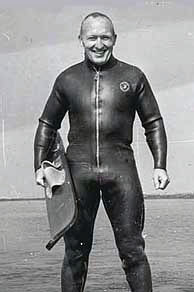
Andy Oddstad getting ready to water ski in the SF Bay, early 1960s
AFTERWORD: Well, we all know that 1975 came and went. I’m sure my father’s predictions were far lower than actual levels of development in California. I’m also certain that he could not comprehend the explosion in housing prices from the 1970s on. For a guy born in 1918, contemporary housing prices would sound like fantasy.
Before the Great Recession, some of his most modest homes that sold for about $9,000 in the 1950s were going for $1 million. (I wish he hadn’t sold them!) They’re down to a mere $800K due to the recession.
Andy Oddstad was a guy who came up in the Great Depression. The article above mentions him working for his uncles after school. He did it because he needed to work if his family was to eat––and the rest of the Oddstad family worked, too. Sweeping out jobs after school wasn’t a hobby. Nor were his two paper routes before school just for fun. He constructed the bicycle he rode to deliver those papers out of scrap from the junkyard. And raised rabbits behind the family home for meat for the table.
Those were hard times.
Oddstad Homes had built over 14,000 homes at the time of my father’s death. Oddstad Homes was the #1 builder of residential housing in Northern California by a wide margin, and #10 in the US at its hey-day.
What was it like having a dad like that? Like growing up in the Marines. Tough, and fair. He really did read Galbraith. He had––and read–-volumes by the philosophers Immanuel Kant and Baruch Spinoza on his bedside table. When he helped me with my homework, I had to have razor sharp pencils, several pens, a pad of scratch paper, good paper for the answers, a straight edge, and a compass at the table before he would sit down with me. I got one explanation, that was it. [Pocket calculators didn't exist.]
Brisk.
I majored in economics for my first two college degrees, due in part to his influence. I’m glad I have that knowledge, though it’s taken me a lifetime to start “listening to my heart” as the New Agers say. I still feel guilty about being a writer and author, though I know it’s what I was born to do. (My dad could not have fathomed the New Age, either. Or free love or the 1960s.)
I owe Andy Oddstad a very great deal. I’ve never seen a person who lived at 100% and demanded that those around him do the same. He shaped me and my life.
What are some of the most important words my father said to me?
First off, he said, “Sandy, there’s no reason a girl can’t do everything a boy can do.” So I took physics and calculus in high school. “And I know how smart you are, so don’t try and tell me you can’t get good grades.” I got good grades.
He held me to a high standard, and I’ve kept it. That’s the most valuable thing I got from my dad. He was the most disciplined person I’ve met. He moved through life at hyper-speed, like he was skating on the edge of a razor blade.
It’s a shame he’s been all but forgotten. He gave a great deal to the San Francisco Bay Area.
But that’s what happens when you die. You get forgotten, your legacy is muddied and claimed by others, and your family can fall apart. Dads: If you want to give your families a great Father’s Day present, don’t die.
About my dad’s building: I know that housing tracts built by one of his competitors, Joseph Eichler, have been named Historical Neighborhoods. There’s an very glossy, slick magazine put out for owners and fans of Eichler homes. I think that’s great. Eichler’s designs were spectacular examples of low cost, good design.
They are not spectacular examples of low cost, good construction. I’ve lived in an Eichler. I know all about huge single-paned windows that leak all the heat in the room and radiant (pipes carrying heated water under the concrete floor) heating that that doesn’t keep rooms warm and can lead to big repair bills when it breaks. My cousin worked as a carpenter building Eichlers. I will not repeat what he said about the quality of their construction. I don’t know if the old saw about how fast they burn down is true. Do Eichlers really burn down in three minutes?
Enough carping. I expect that Frank Lloyd Wright would approve more of Eichler’s work than my father’s. I do wish that some of the folks living in Farm Hill, Linda Mar, Crestmont, Rollingwood and the rest of the communities built by Oddstad Homes might throw together a blog or something.
My dad was an engineer. He was interested in straight lines and economy and that’s what he built. He wanted everyone to have a good, well-built house over his or her head. He was a political liberal, a strong Kennedy man, a man who cared about everyone, not just the rich.
Now is the time to remember our fathers, whoever they were and whatever they did, even if they weren’t perfect and contributed to our personal difficulties. We’re here because of them, whoever they were or are.
My best wishes, fathers. And all the best to you, Andy Oddstad, whom I knew as Daddy. There’s so much you didn’t get to see, Daddy. You have five grandchildren and two great-grandchildren. You missed the Beatles. And we missed you.
Sandy
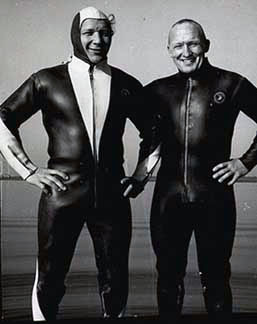
Ray Stern and Andy Oddstad getting ready to water ski in the SF Bay, early 1960s.
Ray was a great buddy of my dad’s. He was a professional wrestler and entrepreneur. The caption my dad wrote next to this photo is, “Ray floats at last.” The caption refers to the fact that Ray was a block of solid muscle. He had so little fat mass that he couldn’t float at all without his wet suit. I think he was the hardest to teach of the many people my dad taught to ski. By-gone times: The Bay is too polluted for skiing now. Ray and my dad are gone.
I’m still alive, though! Alive and writing, Daddy, wherever you are! My father never got to read my books. That’s painful. My dad would have liked them; he taught me how to write and how to be. I write for smart people who demand more than pablum. That’s the fruit of my dad’s influence. He would have liked my work.
Happy Father’s Day, Dads of the World!
Sandy Oddstad Nathan
Sandy’s Amazon Author Page. Click here of on image.
HERE ARE LINKS TO AND DESCRIPTIONS OF SANDY’S SIX BOOKS!
They range from wild sci-fi to adorable children’s nonfiction. You’ll find something you’ll like in the list below:
NUMENON , a novel about the richest man in the world meeting a great Native American shaman
STEPPING OFF THE EDGE, a modern day spiritual companion
TECOLOTE , the adorable kids’ book about a baby horse.
EARTH’S END––the new, three book sci-fi/fantasy/visionary series that takes you to the end of the earth, and beyond.
The Angel & the Brown-Eyed Boy ––An angelic girl shows up on the sidewalks of New York City in 2197. Or is she a girl? Jeremy Edgarton, teenage genius and revolutionary decodes the transmissions. They say the world will blow up tomorrow morning.
Lady Grace––The radiation has cleared. A few survivors make it back to Piermont Manor to start a new life. What they face is a battle more deadly than any they’ve fought. Evolution can work for evil as well as good.
Sam & Emily ––Can love live in an echoing cement bomb shelter three hundred feet below the earth’s surface? Find out in Sam and Emily as headman Sam Baahuhd falls in love with a beautiful assassin.
June 14, 2013
What Makes Men Sexy? What Makes Male Characters Sexy? What Makes Literature Sexy? Why Are We Obsessed with Sex?
I had a brief but interesting email conversation with Rick Mora recently. Rick is a Native American model, actor, producer, you name it. In addition to his other modeling, he’s been on two book covers in the Romance genre. I loved the most recent one and told him so.
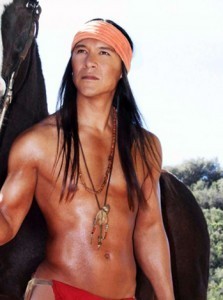
Rick Mora, actor, model, producer
I learned from Rick that Fabio is the most successful Romance genre cover model. This morning, I discovered Fabio has more than 93,000 images on Google and 3,300 book cover images. Here’s a HuffPost slide show of his covers.
I found this very disturbing. I am not a Fabio fan, though I’m sure he’s a very nice person. My previous blog article, Judgment Day, was about the insidious decline of our culture into a judging and blaming mill. I could easily drop into major judging right now, but I won’t. I will say only that Fabio isn’t my cup of tea.
Who is? This is a surprisingly important question. I expect most of those reading this are authors/writers. If you can’t name what turns you on, how can you write it? And–if it turns you on, will it turn others on? We’re talking market appeal here. Can you successfully project your own sensual tastes on a larger population and have them love what you’ve done?
Join this valuable research project: Ask yourself the questions I ask below, and drop me a comment to express what makes men sexy to you.
What makes a guy sexy? What makes a character sexy?
Seeking the answer, I asked my husband, “Who do you think is the sexiest man in the world?”
“Me,” he said, not missing a beat. “And I’m not looking at any other men.”
There you go: what testosterone does. Complete surety. No false modesty. No need to compare himself to anyone.
This is sexy––very masculine. I agree with him. He’s certainly the sexiest man in my universe. He has an additional compelling advantage: He rides. Nothing is sexier than a good looking man who can really ride a horse. All that sensitivity and restraint. Perfect balance. Split second awareness. Fearlessness. The animal vitality and sweat. Control of a powerful creature with a fingertip. Whoa. Here’s a picture:

Barry Nathan riding Leon Gitano BSN, a Peruvian Paso stallion. Nothing like a stud.
Answering the questions making up the title to this post is a surprisingly difficult exercise, but part of the answer came easily. What men have I known who have stuck in my brain/soul/psyche for, oh, 35 years, give or take? What are their characteristics? I have not been physically intimate with any of these men, yet I can’t forget them.
Priests, monks, professors, and bosses: Big, big impact from these mentor-type people. I’ve known a number of priests (Catholic) and monks (Sarasvati order of Hinduism) that captivated me. And there were a few PhDs who caught my eye.
I remember one of the priests who was a professor of philosophy when I was at Santa Clara University. A towering intellect, and towering man, he had a huge head of white hair that flew heavenward. Completely oblivious to what he looked like, the black bathrobe thing that the Jesuits wore in those days often gaped at his considerable middle, revealing a white T shirt. His “bathrobe” was covered with chalk dust. Every inch was a mass of wrinkles. He taught Modern Philosophical Issues. When he lectured, you felt the hand of God. The hand was good, but didn’t mind smacking you around a bit. When he preached, students would walk out of the Mission shaken. They didn’t really understand what he said, but he sure SAID it. Whatever he was talking about was so avant that it barely fit in English. I’ll never forget him.
His counterpart, who was chairman of the philosophy department, was the exact opposite of the professor above. This priest was spare, with not an ounce of extra fat, upright in his posture and very strict in his thought. You could understand what he was talking about. His clothes were immaculate; not a fleck of chalk dust remained on him. He was close to ancient when I took courses from him. Didn’t matter. He had impact.
Monks. I spent twenty five years associated with a meditation group based in India. I’ve known a number of Hindu monks who have impressed me greatly. These people practiced what they preached. They had attained something spiritually. I can remember standing in a hallway next to one of them and getting a contact high. What was it that attracted me to them? Their purity. Their recitation of scriptures, their meditation, their spiritual practice had changed their souls and made them very attractive.
Spiritual masters. I’ve known two meditation masters and a tai chi master. These people had the qualities of the priests and monks to the nth power. The contact high began when you decided to sign up for something they were leading. I could not think within ten feet of my first meditation master. My mind shut down. The energy he gave off was an explosion. Bliss, ecstasy (the state,not the substance), healing of everything radiates from these people. You don’t think that’s attractive?
Guys I’ve worked for. I’ve been very fortunate in that all my bosses have been very cool. One stands out. At the top tier of his field, he started out being a White House Fellow, then got a PhD at the most prestigious university in the country. Taught at Harvard, Stanford, and Oxford. Wrote I don’t know how many major books on business theory. He was the best classroom teacher I have experienced. Was he tough? Mean? Did he yell at people? No, the opposite. He was very clear and mega intelligent, as well as a Zen scholar and practitioner. This showed up in his teaching. Brilliant but soft, innovative but kind. As able to hone in on students’ social and psychological states as he was to read what he’d written on the blackboard. And watching him debrief a negotiation was like watching a surgeon doing a heart transplant. Wow.
Notice that most of the people above were in holy orders. I had no physical or sexual contact with any of them. What made me remember them all these years? A few, primarily spiritual, things:
Intelligence. These men were sharp.
Passion. These men were passionate about what they did.
Vocation. They did what mattered to them and what would impact the world.
Energy. We all throw off energy. Spiritual practice intensifies it and purifies it. It makes us attractive to others. It’s fun, no, wonderful, to be around a spiritual powerhouse.
Integrity. They walked the walk.
Commitment. These dudes were in the game, playing as hard as they could. They were committed for the duration.
None of this says one thing about hair length or color, size of pectoral muscles or other body parts, six-packs, facial construction, or the beauty of a torso or thigh. It’s about what’s attractive to me, and that’s intelligence, intensity, energy and personal power.
As an aside, I think that one of the reasons that so much sexual wrongdoing occurs with the clergy is that what their jobs and spiritual practices make them sexy. People are sexy, but the spiritual lifestyle I’m describing intensifies it and personal energy. If there’s no outlet, look out choir boys.
Before leaving the area of spirituality to leap into the sweaty physical realm, we need to investigate the relationship between sexuality and spirituality. Is there one? Oh, yes. Have you heard of Tantric yoga? Sex and spirituality embrace in all sorts of ways Tantric sex is very, very real. You don’t have to follow any particular practice to set it off, either. Combine disciplined sexuality, ignited spiritual energy, and spiritual practice–you can get yowser-wowser sex of which the Romance industry could not conceive. You can achieve over-the-top spiritual and sexual experience at the same time. Experience that lasts a really long time. Days, even.
Why isn’t more written about sexuality and spirituality? Probably because most writers haven’t experienced it. An interlude in my upcoming book, Mogollon: A Tale of Mysticism & Mayhem, that reads like an over the-top, absolutely impossible, sexual fantasy. It’s not. It’s a write up of one of my experiences. Maybe we’ll get more people writing about the really good stuff if they realize that meditating for twenty-five years will buy them more than the ability to remember their mantra.
How do we go from my spiritual/intellectual description of qualities in men I find attractive to the grunt and groan sex that people write about? Where’s the hot and steamy?
EASY: ADD A BODY.
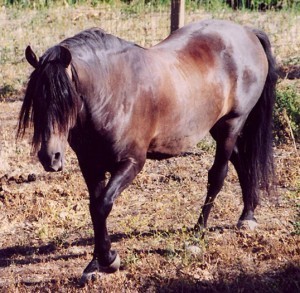
Capoeira BSN, a Peruvian Paso Stallion - Our first stallion, ending his life increasing the number of Peruvian Paso horses in Australia. Many men would love his job.
There’s a sexy male body. A stallion. My husband and I operated a horse breeding farm for twenty years, providing us with a wealth of information better kept to ourselves and other horse breeders. (Tends to be raunchy and explicit.) I’ve always wanted to share this wealth. Now’s my chance. Having watched stallions in action, I can say that nothing on the cover of any romance novel or anything else can compare to a stallion in any dimension. You name it: length, width, reload time. Passion, power, pure male force. Duration, number of partners in one session. They don’t call them studs for nothing.
I’m going to quit now, because this is a super long post. I’ll delve into our topic more and be back in a few days. In the meantime, think about what attracts you in a person and what attracts you sexually. Are they the same?
NEWS FLASH – I JUST DISCOVERED THIS: What makes a man sexy? If I am falling off my horse and a man catches me, he is sexy. That just happened to me. My husband caught me, with our horse trainer right behind him.
Catching me creates a deep and abiding affection, verging on idolization. It doesn’t matter what the guy looks like. He doesn’t have to have six pack abs or anything. If he keeps me off the dirt, he’s a god.
There you go, guys, Sexy 101.
If you’d like to read an intense, beautiful, terrifying, imaginative and sexy book, check out Sam & Emily: A Love Story from the Underground. Can love survive in a bomb shelter 300 feet below the earth’s nuked surface? (Sam & Emily is being retitled The Headman & the Assassin. The new cover is below. Books are the same.)
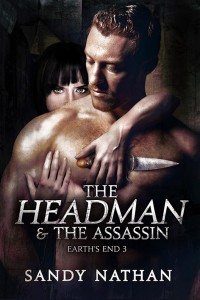
The Headman & the Assassin - I think this is a pretty sexy cover. The guy on the cover is a Russian body builder. And she does stab him in the heart.
Sandy Nathan
Sandy’s Amazon Author Page. Click here of on image.
HERE ARE LINKS TO AND DESCRIPTIONS OF SANDY’S SIX BOOKS!
They range from wild sci-fi to adorable children’s nonfiction. You’ll find something you’ll like in the list below:
NUMENON , a novel about the richest man in the world meeting a great Native American shaman
STEPPING OFF THE EDGE, a modern day spiritual companion
TECOLOTE , the adorable kids’ book about a baby horse.
EARTH’S END––the new, three book sci-fi/fantasy/visionary series that takes you to the end of the earth, and beyond.
The Angel & the Brown-Eyed Boy ––An angelic girl shows up on the sidewalks of New York City in 2197. Or is she a girl? Jeremy Edgarton, teenage genius and revolutionary decodes the transmissions. They say the world will blow up tomorrow morning.
Lady Grace––The radiation has cleared. A few survivors make it back to Piermont Manor to start a new life. What they face is a battle more deadly than any they’ve fought. Evolution can work for evil as well as good.
Sam & Emily ––Can love live in an echoing cement bomb shelter three hundred feet below the earth’s surface? Find out in Sam and Emily as headman Sam Baahuhd falls in love with a beautiful assassin.
June 10, 2013
Judgment Day: Reviews Reviewers Critics Criticism Rankings and Rants with a History of Modern Culture Since 1950
YIPES! IT’S JUDGMENT DAY!
Yes, in the modern age, every day is judgment day. We are surrounded by reviews, ratings, rankings, and evaluations––most of which were created anonymous people judging their fellow human beings. We’re asked to review everything imaginable. We have Amazon reviews, Goodreads reviews, reviews on blogs and everywhere else. We’re asked to “Friend” me, “Like me.” Give a thumbs up or thumbs down to everything.
This trend is accelerating. Social media multiply faster than the ground squirrels in my pasture. Numbers are everything. We brag on-line: “I have 59,000,000 friends.” “People downloaded 100,000 copies of my book last week.” Who has the power? Who has the status? The one with the biggest numbers. Quality is secondary, if considered at all.

In the old days, only God got to judge.
We swim in a sea of judgment, much of it performed by people with no qualifications and suspect motives.
The new world is characterized by anonymity and false identity. When I was getting my MA in counseling, we strove for transparency––not hiding behind roles. We strove for real personal connection, knowing what our feelings and motivations were and stating them honestly.
Now, we’ve got anonymity. The person we’ve just given the lousy rating doesn’t know us, never will, and can’t do anything about what we said anyway. This allows nastiness that no one would perpetrate on someone face to face. Screen names insure the impossibility of finding out who we are.
Want to know about the psychology of our age? Check out Dr. Kimberley S. Young’s work. Caught in the Net: How to Recognize the Signs of Internet Addiction–and a Winning Strategy for Recovery is a great book to start with. She talks about “flaming”–on-line flareups of rage–and the vicious pack behavior you see in some blogs. Here’s Dr. Young’s test to determine if you have an on-line addiction.
ONE OF MY PROFESSORS NAILED IT WHEN HE SAID:
The only legitimate reviewer is a producing artist whose work is better than the work being critiqued. The critique should be communicated to the artist who produced the work––only.
Philip B. Welch, AIA
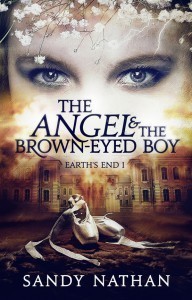
The Angel & the Brown-Eyed Boy
This post was motivated by a couple of reviews. I levitated with joy over a terrific review Glenda A. Bixler of Book Reader’s Heaven gave my book The Angel & the Brown-Eyed Boy. Life was wonderful. Writing was a great profession.
Two days later, I was checking a fact about one of my other books on Amazon, I discovered that it had a new review, too. Except that this one was an extremely negative review written in a particularly nasty way.
Whoa. Those words smarted. Worse than that, they’re posted in public where there they will continue to influence others forever. My mood shifted: Writing became the worst profession in the world, offering no rewards, but endless opportunities for pain.

Dante's Inferno. I wonder why Dante didn't think of an endless stream of bad reviews as a punishment appropriate to the lowest levels of hell?
Everything I have read about dealing with bad reviews says: Don’t respond. If you blow up on line, what you say can go viral and destroy your career. Suck it up. Shut up. Take it. That’s similar to: relax and enjoy being raped.
That approach doesn’t sit well with me. Taking my professional future in my hands, I’m going to respond, but not to the bad review or the reviewer who bestowed it. I’m going to talk about our society and its current mania for evaluation. I’m going to start out with a survey of changes in our culture that I’ve observed during my lifetime.
This post is so long that even I was embarrassed by its length. I’ve cut it into sections and will present them a few days apart. Keep reading. It’s entertaining, and you might find it funny. And valuable.
1. Changes in Our Culture and Social Values During my Lifetime: Or How Our Collective Psyche Lurched Forward––and Backward.
I’m old. One of the nice things about being old is that I’ve lived a long time. I was alive during the 1950s and 60s and remember them clearly. In my world, until the Beatles erupted in 1964, life was exactly as portrayed in MadMen, except way more uptight and without all the sex.
I’m amazed at how much society has changed. Take the quote about reviews and reviewers above. Who’s this Welch dude? Philip B. Welch was the chair of the Department of Creative Arts at Santa Clara University during the mid-1960s. He was an architect of consummate taste and aesthetic development who had studied at Frank Lloyd Wright’s Taliesin West. I was his student. Mr. Welch had a huge impact on my life. He said the words above in class.
I interpret his words as, “If you can’t do a better piece of art than the one you’re reviewing, shut the **** up. If you can do better and have some feedback about the piece that would be useful, have a personal conversation with the artist involved aimed at helping him or her make better art.”
What is unusual about this point of view?
You’d never hear it after 1979.
In 1964, The Beatles blasted us out of the booze-soaked, up-tight fifties, setting off an explosion of consciousness with a simple song called “I Wanna Hold Your Hand.” That revolution was probably fueled with liberal doses of LSD and marijuana, but people changed. They wanted to create a society in which personal worth, kindness, altruistic feelings, and love ruled.
The 60s were an amazing, exciting time that I will never forget. We really believed we could change the world. Life had a freshness and palpable expectation that good would triumph that are gone now.

Typical 1960s Transportation in San Francisco. I can't even describe what the Haight was like. (SF is my home town.)
The revolution of consciousness kept on rolling during the 1970s, when the big personal growth/human potential movement/train-yourself-into-enlightenment wave hit. We had (and did) est, Rebirthing, Lifespring and many other seminars and trainings aimed at cleaning up the nasty bits in our souls and letting the true Self shine through. The big meditation programs arrived from India in the 70s: TM, Siddha Yoga, and others. They really stressed love and lack of judgment. [Post a comment below if you participated in any of these. I did est and Rebirthing in the 1970s. Found both very valuable. I was involved with Siddha Yoga for almost thirty years.]
You have to have lived through those times to realize how different the world is today. You have to have walked down those streets and listened to what people talked about and cared about and did. Folks flocked into the Peace Corps, heading into the developing world in an attempt to make things better. We had the Model Cities Program, Head Start, and the myriad social programs that––guess what, critics––were shown to have measurably improved the lives of participants. And many of us protested the war in Vietnam, putting our lives on the line to create the world we wanted. Conversely, many of us served in the armed forces in Vietnam, putting our lives on the line to create a world we believed in.

Communion. What we still crave, even though the 60s are long gone. (Artist: Lily Nathan)
All that went south in the 1980s.
The 80s ushered in the era of greed, me, gimme, and gimme more. When I think of the 80s, I think of massive shoulder pads, dresses with glitter all over them, granite kitchen counter tops, miles of crown molding, and monster houses with absolutely NO architectural merit. We tricked ourselves out with no guilt. At all. None.
It’s kept on going, right through the Enron collapse in 2001 and the financial meltdown of 2008 and surrounding years. Untrammeled greed piled on more greed. I lived in one of the exclusive towns in Silicon Valley. I didn’t have to watch Inside Job, the Academy Award winning documentary about what happened to our financial institutions in 2008, to know about this. I could go to breakfast at the local cafe, a hangout for the high tech elite. The conversations I overheard substantiated everything I’m talking about.
People who did not live through contemporary society’s evolution from the 1960s until now DO NOT KNOW how much the collective psyche has changed. Large hunks of the population seem to have lost any sense of fellowship, righteousness, and fair play. Kindness. The desire to help others. Love of humanity.
“He who dies with the most toys, wins.” A bumper sticker defining the modern age. I Googled that phrase and learned a lot. The slogan hails from the 1980s, of course. My search showed that I am not the only person to have a negative reaction to it. I also discovered that there’s a web site advising people about dangerous-to-display bumper stickers. It was created in recent years, the Great Recession years, when everyone was losing jobs and was financially stressed. If you make a conspicuous display of materialism on the freeway such as the stickers on that site, someone might take a shot at you. “Most toys” is on the most dangerous list. Here’s a counter opinion:
There’s a dose of reality. Here’s more: Not everyone is a greedy, judgmental SOB today. Some people want to live in a peaceful world where people are kind. Members of clergy, psychotherapists, mystics, and those on a spiritual path all try to live without judging their fellow human beings. They try to see the other person’s point of view and temper their words so they can be heard without causing pain. Lots of just regular folks are like that, too. My friends and family and lots of others are good people.
I try to live without harming others. I’ve worked hard to create a me that I can live with. For instance, aside from doing the 70s as hard as I could, I have an MA in Marriage, Family, and Child Counseling, also from Santa Clara University. I went into that program because of the values the program it embodied. My soul drew me there. I wanted to imbibe the attitudes and skills of the people in that program. And I did.
But for mass society, the days when all that stuff mattered are gone.
The clearest demonstration I see of the Real New Age shows up in contemporary politics. People in Congress can’t agree about anything. And that applies to people in the same party. If those on the same side can’t say nice things about each other or get along, how will they run the country? Do you ever watch the news and see the nasty, judgmental faces on our leaders?
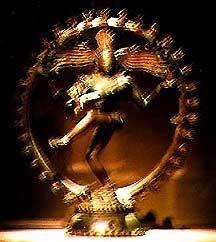
Shiva Nataraj
Where is The Great Soul? Was it squashed with the tragedy of 9/11/2001? No. People pulled together then. Did it die in the financial crash of 2000 through 2008 and beyond? Maybe. Was it the technological revolution of the iPod, iPad, iPhone, and iEverything else that did it in? Or is the social climate the result of the recreational drug of choice changing from marijuana to meth and coke?
2. What Does This Have to Do with Book Reviews and Reviewing?
Reviews and reviewing are symptoms of the ills of our society. Everything I say above applies to book reviews. As a matter of fact, I wrote all this because of a book review.
3. What to do? Well, you could hope for the 60s to come back or join an order of monks, but those are pretty extreme.
Knowledge is power. In the next article of this series, I’m going to talk about the psychological transactions and states involved in judgment. And I’m going to talk about skilled communication. About being skilled people.
Until then,
Sandy Nathan

Sandy Nathan and Tecolote
HERE ARE LINKS TO AND DESCRIPTIONS OF SANDY’S SIX BOOKS!
They range from wild sci-fi to adorable children’s nonfiction. You’ll find something you’ll like in the list below:
NUMENON , a novel about the richest man in the world meeting a great Native American shaman
STEPPING OFF THE EDGE, a modern day spiritual companion
TECOLOTE , the adorable kids’ book about a baby horse.
EARTH’S END TRILOGY––the new, three book sci-fi/fantasy/visionary series that takes you to the end of the earth, and beyond.
The Angel & the Brown-Eyed Boy ––An angelic girl shows up on the sidewalks of New York City in 2197. Or is she a girl? Jeremy Edgarton, teenage genius and revolutionary decodes the transmissions. They say the world will blow up tomorrow morning.
Lady Grace––The radiation has cleared. A few survivors make it back to Piermont Manor to start a new life. What they face is a battle more deadly than any they’ve fought. Evolution can work for evil as well as good.
Sam & Emily ––Can love live in an echoing cement bomb shelter three hundred feet below the earth’s surface? Find out in Sam and Emily as headman Sam Baahuhd falls in love with a beautiful assassin.
June 6, 2013
Succeding in the book world
Things to do to succeed in the book world: Many of these items require years to complete and involve multiple, complicated steps. They also may require some kind of charisma or voodoo.
Learn to write. You can do this while writing your book. Lots of ways to do it: writing groups and courses, working with coaches on and off-line, working with an editor. However you do it, do it.
Finish your book. Then get it edited and proofed and tricked out for publication.
Sign on with a literary agent, if you can. If not, investigate self publishing or creating an Indie Press. Note that this step requires lots of work, either querying or otherwise connecting with agents or doing research on the publishing world.
Publish your manuscript, either traditionally via a publisher or by yourself. If you do it yourself, make sure you have a killer book cover and that the interior is done by a pro. Don’t pollute the universe of self-published books with another badly produced book.
Get the book listed everywhere in print and ebook forms.
Create a web site. Make it search engine optimized and everything else. Bells! Whistles! Contests! Newsletters!
Start a blog. Write on it all the time about stuff people care about and want to hear about.
Make everything search engine optimized “sticky.”
Do everything you can to make your book stand out, including winning book contests, and everything laid out below.
Go on-line and establish a presence on the major forums for writers/readers. That means entering conversations and making friends on-line.
Don’t pimp your book. Which is, cruise around the forums, pick a few do a dive and drop: show up once, dump four pages of info about your book and then leave forever.
Always use good on-line etiquette. Just Google “on-line etiquette”; tons of sources on this topic exist. Here’s a good site with a quiz.
Hire a publicist. A good idea if you can afford it.
Brand yourself!
Target your market, define your niche, figure out who you’re writing for and write to them.
May 21, 2013
I Don’t Write Like a Girl –– or How I Became a Literary Grown-up and Why It Doesn’t Matter
Sometimes the process of blogging helps the blogger as much as those who read the blog. In my previous post, I introduced my new banner (above), handled some feminist and definitional issues, and tossed out a description of the kind of fiction that makes me want to throw up. Namely, the sweet Southern family story packing all the dramatic tension of a banana slug.

BANANA SLUG - This is the UC Santa Cruz Mascot. I was going to put a picture of a real banana slug here, but they're so gross I had mercy on you--and me.
Not being able to leave the topic alone, I rewrote the Southern story, making the plot more interesting by adding pole-dancing, zombies, and a meth lab. By that time, I’d broken through the seriousness of writing all that other stuff. I sat at my computer, laughing.
Exactly at that moment, a powerful inner voice spoke to me: “IT DOESN’T MATTER THAT YOU DON’T LIKE A PARTICULAR GENRE. IF PEOPLE LIKE TO READ THAT STUFF, IT’S NONE OF YOUR BUSINESS. IF THEY WANT TO BE LITTLE GIRLS (OR BOYS) THEIR ENTIRE LIVES, THAT DOESN’T MATTER, EITHER. YOUR JOB IS TO PAY ATTENTION TO YOUR OWN WRITING AND LIFE. DO NOT JUDGE OTHER PEOPLE.”
This was a personal growth moment, a message from my Inner Self. Did I ever need it. If I had posted what I’d written to go here, I would have alienated readers and writers of the major book genres.
So I wrote what follows, which has turned into a “free Kindle short.” I really can’t write anything under three hundred pages. Sorry.

SHIVA NATARAJ IN SHADOW - The Dancing Shiva represents the dance of life. If a force like this taps you on the head, it's best to listen up.
So how should I fill this space?
What I was trying to point out in the “I don’t write like a girl” thing is I don’t write like a girl. My work is gritty, sometimes violent, has strong language, and is very sexy (but not too explicit). My writing also has a very strong and pervasive spiritual thrust (which is nondenominational). It deals with rough subjects, such as: will we grow up as a species and learn to work together before we blow up the planet? (That’s the underlying theme of The Angel & the Brown-Eyed Boy. )
I would give all of my novels solid R ratings. The non-fiction is G rated. That’s Tecolote: The Little Horse That Could, a kids’ book abut a premature baby horse born on our ranch. Stepping Off the Edge is a spiritual companion for today’s world.
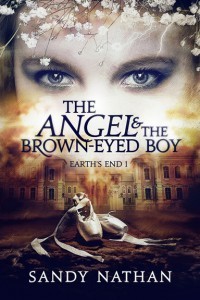
The Angel & the Brown-Eyed Boy - Here's the new cover. Another face of the Angel.
Typically, female genre writers are associated––and this is a generalization––with fluffier subjects. Or flat out romance, much of which has degenerated until it’s close to porn, as far as I’m concerned. Literary fiction is a different matter; female literary authors turn out some of the most profound and beautiful work in existence.
But how about profound, beautiful, hard-hitting, truthful, difficult, transcendent, and inspiring work for men and women? Writing that’s fun and entertaining? That’s what I aim to produce.
Why is my work gritty and hard hitting? Believe me, I’d like to write gentler, easier pieces. But I can’t. (Yet!)
I’ll let my story tell itself.
WE GROW THE WAY WE’RE BENT.

RICK MORA Native American Actor & Model
In his bio, Native American model and actor Rick Mora says, “Planted in the womb of my mother, a seed from the Sun. Birthed in a field of corn called Los Angeles, but raised on a one hundred acre cattle farm. . .”
Lovely words. I contemplated them and they inspired this blog article.
I was born in a hospital in San Francisco and raised in a minefield.
Ours was not the kind of mine that kicked out gold and silver. It was the kind that blew your legs off if you made a false step.
The primary rule of our minefield was: don’t acknowledge that it exists. Never talk about it.
Am I going to talk about it here? Good heavens, no. I’m still shaking from my mine-induced memories. But I will allude to the field and its effects.

BONSAI - We grow the way we're bent
WE GROW THE WAY WE’RE BENT.
Kids model themselves after the people in their lives who are powerful, effective, and successful. These winners become multi-sensory reality templates. Multi-sensory: encompassing sight, sound, touch, taste, and smell. We are poured into the mold of our mentors’ being; they brand us to the bone.
I identified with my dad. He held the power in our family and without a doubt had the most fun. Lining up with this man had pluses and minuses.
On the plus side, I identified with a person who went from a penniless immigrant to owner of one of largest residential construction companies in the United States. I breathed the intoxicating energy of success and was force-fed what I needed to be/do to succeed so mightily.
On the negative side, I identified with a person who founded and owned one of largest residential construction companies in the United States. The guy was tough. You wouldn’t believe how tough. And demanding. My childhood was like being in the Marines.
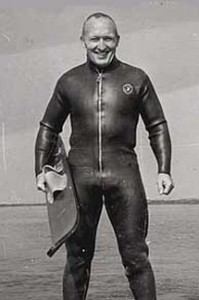
ANDY ODDSTAD Water-skiing in the San Fransisco Bay in the 1960s. He was as tough & powerful as he looks.
My father was driven, an ultra perfectionist, and more capable and effective than anyone I’ve known. He was a volcano of energy, a champion wrestler, and incredible water skier. He lifted weights as big as manhole covers. Expert at reading people, he could negotiate around the most recalcitrant city council and tell who would vote with whom the minute he entered a boardroom. He rose to the top, moving from college athlete and scholar to war hero to captain of industry in a few short years. He always took the hardest course and didn’t shirk anything.
He also demanded that everyone around him reach his mark. That meant me.
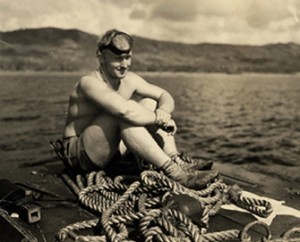
ANDY ODDSTAD IN FULL BATTLE GEAR - This my dad somewhere in the South Pacific during World War II. He belonged to UDT 4, Underwater Demolition Team 4. The UDTs went into occupied waters before the Marines––and blew up mines. This is his style: pick the most dangerous thing you can do and succeed like crazy. He brought home a fistful of medals.
When I was ten, my dad said the most valuable words a father could say to a daughter: “There’s no reason that a girl can’t do everything a boy can do.” He looked at me with those brilliant blue eyes. I felt pierced, the way a whale does when the harpoon hits. “And I know how smart you are. Don’t think you can fool me with your grades.”
He knew what I was capable of and expected me to achieve it. No whining. This knocked the “unnecessary little girl” out of me in one swoop.
WE GROW THE WAY WE’RE BENT.

We lived in the subdivision beyond these gates.
Time passed, life went on. I took physics and pre-calculus in high school and prepared to go to college. The business soared, catapulting my family into a world none of us could have imagined.
When I look back at those years, I see the tender tips of oak branches reaching across the country lanes near my home. Brilliant foliage spilling out of bronze urns that soared far above my head. Hundred-year-old magnolias lining a driveway. We lived on an old estate that had been subdivided. The place was magical.
I recall red-hot speedboats and weekends spent water skiing. Magnificent horses moving around arenas in pristine fairgrounds. Roaming California’s coastal range on my beloved steed. Riding so far into the forest that the boundaries between forest and horse and I blurred, so that all we were was the spirit of the forest moving. I remember riding in a drill team and dancing in my parents’ country club. I’ll never forget the time when we entered a restaurant and the maître de genuflected to my father. Truly.
I was something then, just because of my name.
That life was seductive and I was seduced.
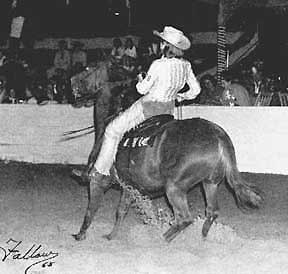 Here I am riding Robin Rose at the Menlo Circus Club.
Here I am riding Robin Rose at the Menlo Circus Club.
This was the last time I showed a horse for twenty-three years.
One January morning in 1964, my golden world collapsed. A drunk driver hit my father head on. My dad died three agonizing days later. My access to the world of horses and horse shows, boats, and country clubs disappeared. I went from a princess to nothing in a few hours.
I have great affinity for Native Americans. They, too, had the kingdom and lost it. I know how that feels.
WHAT DO YOU DO WHEN LIFE HANDS YOU A BOMBSHELL?
1. Get high: People perish when something so massively bad happens. They turn to drugs, alcohol, all sorts of addictions, and destructive behavior. And they die.
2. Get low: Fall into the ocean of depression and despair, self-pity, and blame. Some of the people in this group join the “I am the most abused person in the universe contest.” I know a number of people with traumatic pasts, including myself. “The most abused person” is an actual contest that you see in this group. Entrants compete for who’s had the most rotten life. The contest is great for cultivating self pity, not so hot as a life theme. When I fell into this, I would tell myself, “At least you’ve never been napalmed.”
3. Fix it: We grow the way we’re bent. I had this crazy war-hero, captain of industry, do-it-the-hardest, roughest-way father as my role model. Trying to bring my dad, the life my family lived, and our position in society back, I went on a mammoth achievement binge, working harder than anyone should. I was full-on with it for about fourteen years, and still am probably in it. I ended up with a couple of master’s degrees, part of PhD, careers in economics, and negotiation coaching. I even was principal interior designer for our furniture store! I did the personal growth workshops of the seventies very hard and was associated with a meditation group based in India for twenty-five years.
All of it failed: I didn’t bring back my dad, our family fortune, or social position. I didn’t save the world or stop business cycles through applied economics. I did not cure the emotional ills of the planet through counseling. Nor did I become enlightened.
I did become highly employable. I was Economic Analyst for Santa Clara County (San Jose, CA, the southern part of Silicon Valley). I got to coach negotiations at the Stanford Graduate School of Business, working for my favorite professor ever, Richard T. Pascale, PhD.
4. Shrink it. Get personal/psychological help if you need it. The mental health community exists to help you. I used to think that psychotherapy should be mandatory: When a baby is born––Whaa!––it gets a ticket for lifetime psychotherapy. That’s because I’ve seen people in their fifties who’ve been in therapy a while. If you compare them to folks the same age who haven’t been shrunk, the difference is amazing. Good therapy works wonders.
Years ago, I realized that mandatory, universal therapy wouldn’t work. The problem is that only a relatively healthy segment of the population can benefit from therapy. The people who really need help don’t think they have a problem. And they don’t have the insight into their behavior and the discipline to change if they do get into therapy. Too bad. Only the toughest, most motivated people can profit from counseling or therapy.
Therapy can also be a swamp. How do you find a good therapist? A really good psychotherapist told me, “If you do not see a definite, positive change in the situation that got you into therapy within two or three months, change therapists.”
5. Rise above it. Ahah! At last something that really works. I’m talking about spiritual experience, religious experience, and communion with the source of all that is. Grab on that transcendent path and run with it.

Sandy & Rey de Corazones "King of Hearts." The Bliss of partnership with a horse
I have been graced by spiritual experiences since I was a young teenager riding my horse through the redwoods. Sometimes, I couldn’t tell the difference between my horse, the warm light and green majesty of the redwoods, and myself. I learned in graduate school that this is called a unitive experience. Many more types of religious experience exist, and I’ve been lucky enough to have more than a few of them. I guess that’s the way I’m bent, apart from my family’s influence.
These experiences have thrust their way out of me whenever I needed them. You can read the Author’s Notes from Numemon: A Tale of Mysticism & Money and the three-book Earth’s End series. In those Notes, I tell exactly what happened when the ideas for those books came to me. Hint: mostly they come from really rotten things occurring. My soul processes pain into books.
In addition to the wondrous and magical working of spirit, I suppose that my own internal bending toward the light and search for the divine sets me up for transcendent experiences. And the twenty five years of meditation and spiritual practice I put in might have helped, along with my participation in several churches that reflected my inner reality.

Sandy Nathan and Tecolote - What was truly mine came back to me.
LIFE KNOCKED THE “LITTLE GIRL” OUT OF ME LONG AGO. I was raised in a minefield, but have found that through grace and my own hard work, a mine can yield diamonds and gems, an infinite wealth of insight, fountains of creativity. A life worth living, love and fun and family.
The jewels came to me when I dug deep enough. If my life hadn’t been as hard as it has been, I wouldn’t be able to write the way I do or feel the honed-bright joy.
My journey taught me that what is truly mine can’t be taken from me. What I was supposed to have came back, exactly in the measure that the universe had in mind at the start.
* * *
THE TITLE OF THIS ARTICLE STATES THAT BECOMING A LITERARY GROWN-UP DOESN’T MATTER. It doesn’t. My message from the Divine way up at the top said that. Everything I’ve said above applies to finding the personal you. The you you.This does not have to be reflected in your writing. (Oh, my. Human potential movement heresy.)
You can write whatever you want independent of your deepest Self. So write chick lit, just know that writing it is not going to satisfy your deepest and highest soul. And know that if your chick stuff sells, you’re going to be very happy. So will your publisher. You will have great fun spending the dough you earn. You will have a career and a position in society.
How about if you make money and write to satisfy your soul? And you do it, satisfying your heights and depths, your soul and maybe even your bank account.
It still doesn’t matter. You can write absolute dreck and be a bestselling author. You can write wonderful books and have only your mother and aunt June buy them. You can market 24 hours a day and sell a dozen books. Alternatively, your stuff can hook something in millions of readers and you’ll be a famous author. It doesn’t matter. Your writing success may be a matter of chance not worth fretting over.
In the long run, we all end up the same. That is something that matters. On your deathbed, will you wish that you’d won a Pulitzer prize or sold a million books or had a better KDP Free Day? Or will you wish you’d spent more time delighting in the beauty of the universe and the love of family and friends?
All the best,
Sandy Nathan

Giant Sequoias - Timeless, enduring, inspiring
This is the commercial message part of this post: My books have won twenty-four national awards, most of them in visionary fiction. Why that genre? Because without the visionary part of my life, without my contact with the source of Being, I’d be dead. I’d be a suicide, or drug overdose, or an accident. Kaput. I am alive because I went to that place, that fountain of love and beauty and acceptance and healing. That’s why I write the way I do.
What do I consider the hallmarks of visionary fiction? (1) It has a moral core. To me, a moral core means that the universe and the writing runs on rules of decency and fairness. No matter how far from these we may stray. No matter how bad things may become in my work (or in life), something exists that is righteous and will move me/my characters toward righteousness. Doesn’t mean happy endings. (2) Some characters will aadvance toward a more elevated, kind, good, educated, and individuated state. Not all of them. I’m not one that believes humanity will evolve so that we all ascend to the heavens at once. Some people will evolve and move to higher levels of human development. The rest will be headlines in tabloids.
By purest happenstance, a whole bunch of people write like me, or like themselves, rather. If you look to the right of this post, you’ll see a badge for the Visionary Fiction Alliance. I’m a founding member. If you go to their site, you’ll find all sorts of interesting posts and articles about the visionary in literature.
Sandy’s Amazon Author Page. Click here of on image.
HERE ARE LINKS TO AND DESCRIPTIONS OF SANDY’S SIX BOOKS!
They range from wild sci-fi to adorable children’s nonfiction. You’ll find something you’ll like in the list below:
NUMENON , a novel about the richest man in the world meeting a great Native American shaman
STEPPING OFF THE EDGE, a modern day spiritual companion
TECOLOTE , the adorable kids’ book about a baby horse.
EARTH’S END––the new, three book sci-fi/fantasy/visionary series that takes you to the end of the earth, and beyond.
The Angel & the Brown-Eyed Boy ––An angelic girl shows up on the sidewalks of New York City in 2197. Or is she a girl? Jeremy Edgarton, teenage genius and revolutionary decodes the transmissions. They say the world will blow up tomorrow morning.
Lady Grace––The radiation has cleared. A few survivors make it back to Piermont Manor to start a new life. What they face is a battle more deadly than any they’ve fought. Evolution can work for evil as well as good.
Sam & Emily ––Can love live in an echoing cement bomb shelter three hundred feet below the earth’s surface? Find out in Sam and Emily as headman Sam Baahuhd falls in love with a beautiful assassin.
April 27, 2013
I Don’t Write Like a Girl –– What Do I Mean by That?
How do you like my new banner? I love it. I don’t look like the woman in the picture, but I get a feeling of power just knowing she exists. I wrote a blog article about the banner and the slogan it bears, which I thought was great. I handed it off to one of my friends, a feminist, for feedback and was surprised by her response.
In saying “I don’t write like a girl,” my friend assumed that I was working off of the poisonous notion that girls do things one way and boys do them another. This is called “gender essentialism” and is reviled by feminists everywhere.
That was not what I was writing about.
However, as a mother of two daughters and a son, I will say that boys do things differently than girls from the get-go. Despite my best feminist-engendered attempts, I never got my daughters to play with toy soldiers and Tonka trucks. Nor could I get my son into a tutu.
So expel me from the feminist movement. As billions of mothers all over the planet will attest, behavioral differences between male and female kids/people exist. These are not necessarily induced by the gender and identity distorting, soul debasing, social and psychological systems in which the kids find themselves trapped.
The best example I know to illustrate how boys and girls are different happened in the days following September 11, 2001. When terrorists blew up the Twin Towers, shock and trauma tore away our social conventions for a moment or two. We hugged and supported each other, grieving members of a common tribe.
At the time of the attacks, my daughter was doing her stint at Sarah Lawrence College’s Early Childhood Center, one of the highest ranked preschools in the country. Bronxville NY, Sarah Lawrence’s location, is 40 minutes from NYC. They could see the smoke rising and practically feel the shock waves when the attack occurred. The kids were as traumatized as anyone else: their social conditioning was stripped away.
The kids in the classes my daughter TA’d created structures during playtime, using blocks and toys. She photographed these and wrote her senior seminar paper using the photos.
What did the children’s constructions reveal? The little girls drew pictures of womb-like shelters, protecting structures, and safe hiding places. The boys’ pictures were full of thrusting missiles stuck up in the air, fighter planes, and explosions.
The kids reacted like themselves, and it wasn’t the way feminists said they should.
I thought feminism was about freedom.
When I write “I don’t write like a girl,” I am talking about THE UNNECESSARY LITTLE GIRL I will explain this.
Long ago, I led a T-group for Dr. David Bradford. Dr. Bradford is/was a professor at Stanford’s Graduate School of Business and an expert on organizational behavior. Organizational behavior––how people behave in institutional settings––began when analysts realized that businesses didn’t fail because people don’t know enough linear programming.
Businesses fail because people can’t problem-solve effectively, create and actualize plans, and get along with each other. Organizational behavior experts seek to train students to succeed in the personal side of business. The T-group (Training-group) gives participants feedback on how they come across and how effective they are in influencing the other group members. It’s group therapy without the therapy.
My co-leader and I––we were gender-balanced: he was a guy, I was, and am, a woman––were responsible for seeing that no one got too beat up in the group sessions. The class, known by the students as Touchy Feely, was a big enterprise. My partner and I rode herd on twelve students. Six other groups also had twelve students each. All the groups were supervised by Dr. Bradford. Another professor ran a similar operation. The course consisted of two professors, twenty-four facilitators, and 144 students.
At the end of the term, we went on a retreat at Pajaro Dunes, a seaside vacation/meeting site. At that time, Stanford brought in the heavies: world-class organizational facilitators. These were people who changed lives and saved businesses with their personal skills. They were the Einsteins of interpersonal relations.
The female participants were really excited: one of the big shots was a woman! Not only that, she was a mother, bringing her daughter and a caregiver to the retreat so she wouldn’t be separated from her child. She was combining motherhood with high level professional achievement.
Holy crap! She was the role model we sought!
Not only that, she had just come from doing a training at the PENTAGON with GENERALS! Yes, had she worked with honest-to-God Generals. I hyperventilate thinking of it.
What was she like? Did she walk in wearing six guns? Chain mail? A power suit and $300 makeup job? Did her chakras glow?
She was an ordinary woman, very much at home in her skin with no pretension of any sort. She had iron gray hair, styled somehow. She had a medium build, neither model thin nor overweight. I don’t remember what she wore; it was forgettable. I perceived her as powerful, intelligent and kind. And soft. She wasn’t tough.
She sat in a circle with the facilitators and students and changed everyone’s lives. I don’t remember a thing she said––except for one thing, which I’ll get to––but I remember her impact thirty-five years later. I remember her kind softness and how she touched me. That’s power.
At one point in the proceedings, she looked across the circle and spoke to one of the female participants. “I sense in you an unnecessary little girl.”
The woman she spoke to was a grown up little girl: forever cheerful and perky. Helpful and smiling. She spoke in a high-pitched little girl voice and acted cute . A little girl trying to please Daddy, at age 35 .
The way the facilitator delivered her message allowed the woman to absorb it and acknowledge that it was true. You could watch her change as she sat there. If she had continued to behave like a little girl, her professional life would have been stunted. But it won’t be, because of that skilled group leader.
The woman who molded generals didn’t lecture us on permissible vocabulary, explain why some things were sexist, or talk about changing the world for women. She just did it, and very kindly.
What I’m writing about in this blog post is the UNNECESSARY LITTLE GIRL. We see them everywhere: woman/girls who never grew up and claimed their power.
Famous examples: Marilyn Monroe and Dolly Parton (Of course, both of them made a bundle and are cultural icons. Obviously, acting like a grown up is not needed for success in entertainment.)
Books: Pretty near everything written some genres. The little girl shows up in all types of romance, from Viking to paranormal. Chic lit, women’s lit, cozy mystery. All the categories of erotica. Probably more. All of books in these categories don’t feature immature heroines, but a bunch do.
Anywhere there’s a wimpy, dependent female clinging to her man or waiting for him to rescue her, you have an unnecessary little girl.
Of course, these books are some of the biggest selling ever. The mass markets love them. Their authors can end up rich and famous. Writing about adult children doesn’t seem to hinder success in popular writing. ;-(
Want an example of the kind of book that drives me wild? It’s the saccharin family drama, centered around a charming family with which all of us can identify. Many of these books are set in the South, y’all.
The plot is a variant of this:
Very slight tension exists between Mom and Dad, due to extremely mild life-stage issues. The real story revolves around Petunia, their older teenaged daughter. Will the boy that Mom and Dad approve take her to the Prom? Or will that Other Boy, who is flawed somehow, ask her first?
The dramatic climax revolves around Grannie getting Petty’s prom dress done in time. This involves Heavy Sewing. The family worries about the dress’s imported fabric wrinkling excessively. Petty goes to the prom with Steve, the boy Mom and Dad wanted her to go with. They are happy. So is Grannie. The dress doesn’t wrinkle.
That’s the level of conflict in these books.
I would change this plot thusly:
Mom and Dad on the verge of divorce. Who’s to say why? Maybe Mom’s pole-dancing or Dad’s philandering. Whatever, they’re trying to hide it from the kids, who know all about it.
Mom and Dad want Petunia to go to the prom with Steve, the captain of the football team and “Most Likely to Succeed” in their graduating class. Petunia wants to tell her parents that she really would like to go with Sally, but can’t find the nerve. Meanwhile, the class nerd, Bernie, is in love with Petunia.
Grannie has a dress from the Bloomingdale’s catalog shipped to the tiny, but very happy, town where they live. She’s sick of sewing for everyone and says so. Then Grannie announces that she’s going to Puerto Vallarta with Howard, who owns the car dealership three towns down.
Fast-forward ten years. Steve is in jail for running a meth lab that could supply the half the continent. Bernie the Nerd is a billionaire, having founded Zoomdle, a social network search engine that lets you spy on your neighbors. He married Sally. Petunia has run off to Boston hoping to meet the girl of her dreams. She is a firefighter.
Mom and Dad sit at home, wondering where they went wrong. Grannie and Howard live in Florida. They are unmarried, but please don’t tell Mom and Dad.
Throw in a few zombies and vampires, you got a hit.
Continued soon . .
April 8, 2013
Numenon: A Tale of Mysticism & Money – Silicon Valley’s Corporate Culture Meets a Great Shaman and his People
Have you heard of Numenon: A Tale of Mysticism & Money? You might have. Back in 2009 when it came out, Numenon was Amazon Kindle’s #1 ranked title in three categories of mysticism for about a year. It cruised around the 1,500th level of Kindle sales, which is phenomenal. I did nothing to promote the book and really didn’t think its performance was anything special. Until it was over.
Now I feel about Numenon the way I feel about all those pictures of myself that weren’t taken when I was young and beautiful. “I only I’d known what would happen . . .” Alas, no time for whining.
I’d like to introduce you to Numenon for the first time, or the second or even third. The fastest way to do it is like this:
Numenon is the story of a group of people trying to reach their authentic selves, and God. Its characters include the richest man in the world, Will Duane, and a great Native shaman known as Grandfather. The contingent from Numenon, Inc. travel to a retreat given by the shaman in the New Mexico desert. Many things happen as the team makes its way to the retreat site, a supernatural place which is probably the greatest power spot on the planet. Evil strikes when they’re most vulnerable.
Even with all the hoopla and action, the book is essentially about people seeking to fill the aching void in their hearts with something real.
I’ve written about Numenon in other articles, but I want to talk about new things. Some of these things are pretty obvious, but no one’s asked about them. I also want
to show you how it feels to hang out with top Stanford and Harvard MBAs (Master’s in Business Administration), a shaman, and the richest man on earth.
First off, where did I get that hard to pronounce, weird title? What does numenon (or noumenon) mean? It’s the thing-in-itself, reality beyond the material world. We can never know the numenon. All we can know is what comes in through the senses. Our reality is limited to our brains’ interpretation of incoming nerve impulses. We cannot get to the world as it is. Ever. Immanuel Kant laid out the problem in 1783 with The Prolegomena to Any Future Metaphysics.
Why is this important? It’s the Western equivalent of what Eastern philosophy––Hinduism and Buddhism and other schools of thought––has said forever: the world we live in is an illusion.
Why did Will Duane pick Numenon as the name of his corporation? He’s showing that he’s intellectual, and hip. Also, he has close to a major in philosophy as an undergraduate, a course of study that saved his life, as it did mine. He’s interested in the numenon, which we can only infer, and its opposite, the phenomenon, experienced reality, with which we’re stuck.
What’s that image on the cover of Numenon? It is based on the Shiva Nataraj, the Dancing Shiva. Shiva is one of the Hindu trinity, the part representing destruction, but which also has a powerful creative backwash. Shiva is also the all-pervasive aspect of God, existing always and everywhere.
Numenon’s founder and CEO, Will Duane, chose the Shiva Nataraj as his corporation’s logo. Numenon is the largest and most powerful corporation in history, named after a difficult philosophical concept. Its icon is the face of God.
We’re not talking about reality TV or game shows here. I write for grown-ups, about big issues. And I don’t write like a girl. I’d give Numenon an R rating if it were a movie.

Numenon won six national awards. Winning the Silver Nautilus in the Bicultural Category was a thrill. The Nautilus Award acknowledges superior books making a contribution to world peace and the evolution of consciousness. People like the Dalai Lama have won it. The Silver Medal in the IPPY Awards (Independent Press Awards) was also a thrill. Thousands of books were entered. Numenon won the Silver Medal in the Visionary Fiction category. The wins in Best Books and Indie Excellence were also thrilling. Numenon won in multiple categories in these awards: Visionary Fiction, Religious Fiction, and Multicultural Fiction.
THE STORY:
Numenon is about the richest man in the world going to a spiritual retreat held by a great Native American shaman. The book is essentially the Native world juxtaposed against Silicon Valley. It’s a search for God and meaning. The story could easily degenerate into a stereotyped tale about the good, spiritual Natives vs. greedy, bad corporate people. It doesn’t.
LET’S TALK ABOUT THE TWO CULTURES REPRESENTED IN Numenon. WE’LL START WITH SILICON VALLEY. I know most about that. I was born in San Francisco and lived in the heart of what became the Valley most of my life: in the towns/cities of Palo Alto, Cupertino, Atherton, and Woodside.
Numenon’s hero is the richest man in the world. Do you know any extremely successful people––those who made the money themselves? They’re a little different than regular folks. I haven’t met Bill Gates or any of the planet’s economic luminaries. I have met my dad. He rose from a penniless immigrant to the owner to the 9th largest residential construction company in the US in its heyday. People do not attain that kind of success because they’re lazy or stupid.
My dad moved as fast as a human being can go, dancing on a razor’s edge. He was brilliant, disciplined, and way beyond hard working. Explosive. Demanding. As inspiring as any minister. He had visions prophetic dreams–he wouldn’t call them that, but I knew what they were when he talked about them. The image of the soulless businessman is incorrect.
What was it like living with him? Like having Secretariat in the kitchen. Thrilling and terrifying.
Will Duane is based somewhat on my dad, and on many other men I knew when I lived in Silicon Valley. He’s not an unusual type, though I think my presentation is unusual in that I present spirituality in a businessman. It shows up differently than it would in a meditation master, but it’s there.
I WAS ASKED HOW I WOULD CAST THE BOOK IF IT WERE MADE INTO A MOVIE.
Starting with the Silicon Valley side:
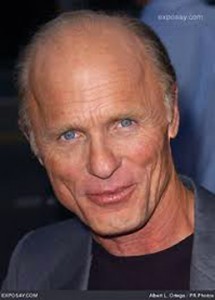
Ed Harris as Will Duane, the Richest Man in the World
I’d put in for Will Duane, CEO and founder of Numenon. has the intensity and intelligence, as well as acting ability, to play someone as powerful, and tormented as Will Duane. I will never forget the visceral pain of Harris’s performance as a gay man dying of AIDs in The Hours.
Will’s staff: Will goes to the Native retreat in a caravan of matched RVs, including his own million-dollar motor home. Over-the-top is the Numenon way. He brings a professional and support staff to the retreat, including a world-class chef. “The Best of the Best: That’s Numenon.”
Will only hires first-in-their-class MBAs (Master’s of Business Administration) from top graduate schools for his personal staff. Do you know what it means to be first in your class at the Harvard Business School or the Stanford Graduate School of Business?
Think Secretariat on speed. You have to be around a major graduate school to feel the intensity, intelligence and competitive drive.
Actually, to get the feel of Silicon Valley, go here: Buck’s of Woodside. Literally go there, for breakfast. Buck’s is a zany restaurant in the laid back and incredibly wealthy Town of Woodside.. The elite of the tech world––venture capitalists or VCs–– meet at Buck’s for breakfast; the action is over at 9AM. Netscape and I don’t know how many other tech firms were created over oatmeal and coffee at Buck’s. I walked in one morning and felt like the turkey we deep-fried last Thanksgiving when it hit the oil. Zapped and sizzling. I’m surprised no one was levitating. A geek sat at every table. Laptops were required, ties were not. Everyone had a deal going down. If you can get to Buck’s, be sure and steal the menu. It’s hysterical. Say hi to Jamis McGiven, the owner, for me. We’re old friends. You gotta feel the vibe to get the Valley.
More on what top business schools and their denizens are like: I was in the doctoral program at Stanford’s Graduate School of Business once (“the year I almost got an ulcer”). One of my fellow doctoral students had been first in his Stanford MBA class before deciding to get a PhD. Really nice guy. He’ll probably take over the world one day.

Hillary Swank as Melissa Weir
That’s the kind of person I’m describing when I say Hillary Swank could play Melissa Weir, the Harvard MBA who is Will Duane’s protégé. Melissa’s achievement in school and at Numenon is astonishing. Hillary is smart, intense, and a super actress. Plus after playing in Million Dollar Baby, she could knock the bad buys into the next county, just like Melissa.
Choosing a photo of Hillary as Melissa was tricky. Most of the photos show her partially undressed and looking sexy, or beat black and blue as in Million Dollar Baby. Your typical top-of-her-class Harvard MBA might go around partially undressed, but not during working hours. She might feel as though she’d been beaten, but most likely, it wouldn’t show. Stuff that happens in boardrooms may hurt, but it won’t leave bruises. I chose the picture of Hillary Swank above because it has that racehorse at top speed. That’s Melissa Weir.
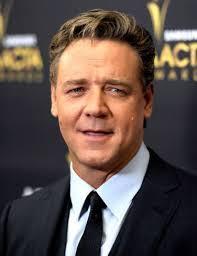
Russell Crowe as Doug Saunders
Russell Crowe would do well as Doug Saunders, Will’s hatchet man and the corporate bad boy. Doug was top of his MBA class at Stanford and has adapted to the Numenon code, which is something like, “If you can screw it, do it.”

Jon Walker––Will Duane's Private Chef
Jon Walker is Will Duane’s private chef, “the best chef in the world.” Numenon culture requires that he be the best. Although he looks about twelve years old in the photo, Jon graduated from Le Condon Bleu in Paris, learning culinary technique as well as restaurant and hospitality management. He cooked at top restaurants in New York, Paris, and San Francisco before working for Will Duane. During Numenon, Jon is grieving the death of his soul mate, ‘Rique Maldonado, a top San Francisco interior designer. ‘Rique died of AIDs.
I’m shining the spotlight on Jon because he has a major role in the Bloodsong Series. I’ve just completed drafts to two books in which he is a main character.
WHAT ABOUT THE NATIVE AMERICAN SIDE?
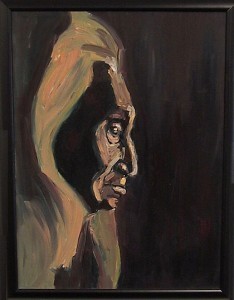
Grandfather by Lily Nathan
Grandfather, the shaman who is the heart of Numenon and the whole Bloodsong Series, is impossible to cast. I’ve had the good fortune to study with two meditation masters and a tai chi master. I did this over a long time––about thirty years, all told. When I got within ten feet of my first meditation master, my brain would bliss out so that I couldn’t think. People in the meditation hall (including me) routinely had experiences similar to those in the Bible. Visions, raptures, prophetic knowledge. Love overflowed in every direction. The experiences I had in long––all night, sometimes––chants were so intensely pleasurable that I can imagine nothing better, including everything.
What is being with these giants of humanity like? The lift off factor is amazing. If you don’t get a contact high from them, they’re not the real thing. Any actor playing Grandfather should be able to project the ecstasy so that viewers feel it. He’s not just a cute old guy.
I used the painting of Grandfather above as an indication of what Grandfather might look like. The painting is by Lily Nathan, my daughter.
When I was writing Numenon, I modeled Joseph Bishop––the name given to Grandfather by white people in the Indian Schools––after the spiritual masters I have known.
I apparently nailed him. One person who had studied with a Native shaman told me, “You really got the shaman. The man I studied with was exactly like that.” I’ve also had Native Americans tell me, “I want to study with Joseph Bishop.” Sorry, he doesn’t exist.
While a number of actors could portray people from Silicon Valley, no actor could portray Grandfather and his Power.
OTHER NATIVE AMERICAN CHARACTERS: Four thousand people attend the retreat. All but ten are Natives. Many casting opportunities exist. I’ll pick a few.
Wesley Silverhorse has a small part in Numenon. His part is larger in Mogollon, Numenon’s sequel, and keeps going through the rest of the Bloodsong Series. But he could have a one-line part and take over the book. He’s that spectacular.
Wesley Silverhorse is an archetype. The word “archetype” derives from the Greek and Latin, meaning “beginning, origin” and “pattern, model, type.” An archetype is the pattern for a certain type of human being. Many archetypes exist. The earth mother, seductress, child, hero, martyr, wise old man/woman, warrior, mentor, and trickster are archetypes. Oh, yeah, the devil, aka Satan, is an archetype.
The easiest way to explain archetypes is to tell a story. Numenon has been around in draft form since 1995. The character Wesley Silverhorse popped into my mind early on. He is an archetype known as: The Babe. He’s gorgeous. As the Hero, he’s also kind, and smart, empathetic, brave, and as spiritually adept as most saints. He’s an unbeatable Warrior. Because of his spiritual Powers, the People believe he will be Grandfather’s successor. He is so good looking that even old ladies like me swoon imagining his comely form.
Wesley Silverhorse became a fixture in my family’s life. If I was driving with my daughters and saw a fantastic looking, maybe Native, guy, I’d shout out, “Whoa! Is he Wesley?” The girls would respond, “Nah, that guy back on University Ave. was better.”
This developed into a code. A man could be “half a Wesley” or a “quarter of a Wesley.” We never got a full Wesley, no one could be that good-looking, but the search was fun. It was a great way to bond with my daughters. Try it with your kids.
The point being that Wesley can’t exist in the real world. Nothing is as glowing as the contents of consciousness, and Wesley is that––the construction of my subconscious. (A note about this. Archetypes can be dangerous. They are mesmerizing, and very powerful psychologically. If you find someone who looks like Wesley and toss your hubbie of thirty years in a lust-flavored rush, that is almost certainly a mistake.)
So, who would I cast as Wesley Silverhorse? I started by doing basic research, Googling Beautiful Native American Men. This search provided many tantalizing possibilities. Check it out. Everyone needs inspiration.
I quickly settled on (drumroll . . .) Rick Mora. You’ll see him all over (and see pretty much all of him) on his website and the Beautiful Native American Men search. He comes about as close to the fictitious Wesley Silverhorse as I can imagine. (In the interest of scholarly investigation, I will keep looking, of course.)
The only person in the world better looking than Wesley Silverhorse is his younger brother, Benny. Rick Mora could play him, too. (I chose the photo below with a horse peeking out because Wesley & Benny Silverhorse are superb horsemen. Being raised on a ranch in Wyoming will do that.)

Rick Mora
Exceptionally beautiful people face a problem: objectification. Admirers turn them into collections of body parts and take away their essence. Beautiful people have many qualities in addition to their looks: moral principles, feelings, values, will, drive, intelligence, loyalty, love, fidelity and many other talents and attributes. Those who focus on looks alone miss all that and reduce human beings to objects. A loss for everyone.
Traditionally, women have been objectified most: Marilyn Monroe and all the Playboy centerfolds. Now men are being objectified by women. Jon Hamm (the astonishingly good-looking star of Mad Men) has complained of this. Here’s an article about it (Don’t be shocked. This article has some pretty explicit discussion. It’s also funny.)
I’m sorry, Mr. Mora, if I have objectified you. I’d like to invite readers to check out his web site. He’s involved with a number of causes and is way more than a pretty face.
Other Native American cast members: The characters go on and on––this book would be a Native American actors’ Stimulus Package if made into a film. (I’d settle for a mini-series like Game of Thrones . . .)

Sacheen Littlefeather
Elizabeth Bright Eagle, MD, MPH is one of the most important characters in the book. Dr. Bright Eagle is an internationally respected physician and philanthropist. The only things she can do better than heal are shoot and ride. Elizabeth was born and raised on her family’s cattle ranch in southeastern Oregon. She’s my kind of heroine.
Actress Sacheen Littlefeather attained notice when she turned town the Academy Award on behalf of Marlon Brando. Brando was protesting the treatment of Native Americans in films. I think she’d make a great Elizabeth.

Adam Beach as Bud Creeman
Bud Creeman is another of my favorite characters. Constantly underrated by everyone but Grandfather, Bud saves the day. He has a lovely sweetness and essential kindness. Adam Beach could to this role. Unfortunately, to play Bud, he’d have to gain forty pounds and age fifteen years.
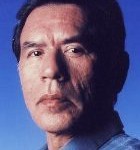
Wes Studi
could play a few parts. He’s got all the intensity of Ed Harris. Wes could play Dr. Tyler Brand, the very cool Native American professor and spirit warrior. Or Paul Running Bird, Mr. Sleaze.

Tantoo Cardinal

Irene Bedard
Irene Bedard should be in the film just because she’s beautiful. She could play half a dozen parts.
We talked about Wesley Silverhorse being an archetype. Do other archetypes show up? All the characters I’ve discussed are archetypes. There’s another big one: When you’re talking about ultimate good, what arises in response? Ultimate evil. What’s that? The Dark Lord, Satan.
The only thing I like better than writing good guys is writing bad guys. The writing starts to sizzle when the villain appears. The Dark Lord has a bit part in Numenon and a major part in Mogollon, its sequel. Which I’m working on . . .
That’s it. If you want to buy the book, you can get it on Amazon as a hardback or a Kindle version. The hardback is beautiful. You can also get the hardback from me for less than half of what Amazon’s charging.
 Numenon: A Tale of Mysticism & Money
Numenon: A Tale of Mysticism & Money
Why am I telling you this? Because NUMENON’S sequel, MOGOLLON: A TALE OF MYSTICISM & MAYHEM, is coming. You might as well read NUMENON so you’ll be up to speed when all hell really breaks loose.
LINKS TO SANDY’S SIX BOOKS!
They range from wild sci-fi to adorable children’s nonfiction. You’ll find something you’ll like in the list below:
NUMENON , a novel about the richest man in the world meeting a great Native American shaman
STEPPING OFF THE EDGE, a modern day spiritual companion
TECOLOTE , the adorable kids’ book about a baby horse.
EARTH’S END––the new, three book sci-fi/fantasy/visionary series that takes you to the end of the world, and beyond.
The Angel & the Brown-Eyed Boy ––Tomorrow morning, a nuclear holocaust will destroy all life on Earth. Only two people can stop it: a sixteen-year-old tech genius and revolutionary and an angelic visitor from another planet.
Lady Grace––The radiation has cleared. A few survivors make it back to Piermont Manor to start a new life. What they face is a battle more deadly than any they’ve fought. Right away they learn that evolution can work for evil as well as good.
The Headman & the Assassin ––He knew her job was murder––murdering people that is. Sam Baahuhd had been the village headman for 22 years when a nuclear holocaust forces him and the ninety plus other villagers into an underground bomb shelter. When Sam carries a naked stranger into the shelter minutes before the bombs go off, he has no idea that she will set his life on fire.
July 17, 2012
Can I Achieve Fame and Glory by Giving Away an Angel? Or––Does Amazon’s KDP Giveaway Program Work?
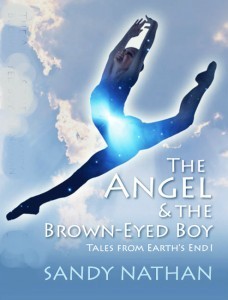
The Angel & the Brown-eyed Boy--The story's even better than the cover. Really.
I am the only person I know who spent more than a month working beyond reasonable limits, especially reasonable limits for someone rediscovering from surgery, on an Amazon Bestseller Launch Day only to sell a lousy 13 books. It’s written about here. The idea was to pick a particular day on which to launch your book and bribe your friends, or anybody, into buying it on that day by offering downloadable prizes. This would cause the Amazon book counters to go crazy and you’d get a best seller and lots of money. No one’s doing Amazon Bestseller Days anymore because so many people did them that the system broke. Doesn’t work any more.
OK. The bestseller launch I did was a failure on almost every count. (Documented in the link above.) It was horrible. I vowed never to do anything so stupid again. (This is always a dumb vow, since the human capacity to do stupid things is well documented by history and the tabloids.) Not only that, my family has a history of not doing well on gambling type, or just winning type, activities. (My father was very successful, but he died young. And my grandmother once won a mink stole at a church raffle.) Other than that, and a few hundred horse show ribbons and a few championships, The Secret eludes us.
I say this to introduce my first KDP free program, which is starting this Saturday, July 21, 2012, and ending Sunday, July 22, 2012. At some point. (Amazon is a little vague about when these things begin and end.) If you sign up your Kindle book for Amazon’s KDP program (which you do by hitting a button on your Kindle dashboard), you get to pick 5 days in a 90 period during which Amazon will give your book away for you. People––real people that I know––have made tons of money on this and created gigundous careers and written books about their success. See my friend Cheryl Kaye Tardif’s book, How I Made $42,000 in One Month Selling my Kindle eBooks, for instance. I am launching into this endeavor based on my faith in Cheryl’s result. Hopefully it wasn’t just for Cheryl.
I have the horrible feeling that I’m walking into another Amazon Bestseller Day, but this time one where I don’t sell a lousy 13 books, I give them away. I also scheduled (inadvertently) the free days right when we’re leaving for vacation, so I’ll be traveling and packing and so on, instead of stomping the internet letting people know about my giveaway. And I’m right in the middle of a rewrite of my monster novel, the sequel to Numenon. I’d rather be writing than trying to figure out Hoottweeter, or whatever it’s called.
So, with that auspicious intro, I’m letting you know that:
(1) I’m going to write up this KDP thing. I’ll tell you the real skinny as it plays out. This series is going to be really great, because unlike some people who write books about this kind of thing and make tons of money, I have no skills or inclination to market and a track record to match. If I can do it, you definitely can.
(2) YOU can get a Kindle of my multi-award winning, super-well reviewed, knock your socks off sci-fi/visionary fiction book, The Angel & the Brown-eyed Boy, this Saturday & Sunday, July 21 & 22 for free! Just click that link, check to make sure the price is actually $0.00, and download away.
Now I’m going to go learn Hootwinger and bombard the world with the good news of the free The Angel & the Brown-eyed Boy every hour.
And I’ll let you know how the free The Angel bit works out!
Sandy Nathan
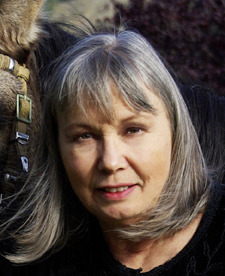
Sandy Nathan is the winner of twenty-two national awards for her writing. She’s won in categories from memoir, to visionary fiction, to children’s nonfiction. And more.
Sandy’s books are: (Click link to the left for more information on each book. All links below go to Kindle sale pages.)
Sam & Emily: A Love Story from the Underground (paperback. Kindle coming)
Lady Grace: A Thrilling Adventure Wrapped in the Embrace of Epic Love (paperback. Kindle coming)
The Angel & the Brown-eyed Boy
Numenon: A Tale of Mysticism & Money
Tecolote: The Little Horse That Could
Stepping Off the Edge: Learning & Living Spiritual Practice
May 24, 2012
The Bookie’s Son by Andrew Goldstein –– A Your Shelf Life Review
A 100% Satisfying Read––Two Thumbs Enthusiastically Up!
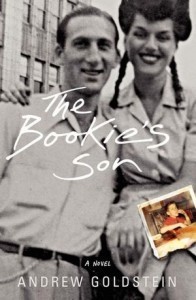
The Bookie's Son by Andrew Goldstein
I was charmed by this book before opening it. First, the title: The Bookie’s Son. Titillating and a bit shocking. Who has a bookie for a dad? I must have been fated to read this book because the couple on the cover look quite a bit like my parents in the early 1960s. I was positively inclined toward it from the start. The book delivers on its promise.
The story unfolds as twelve-year-old Ricky Davis comes home, goes into his parents’ bedroom and begins taking bets for his father’s bookmaking business. His whacky grandmother wanders around, with and without her teeth and bowl of Jell-O.
The scene was so bizarre that I thought, This is going to be an hysterically funny family drama, sort of like Leave It to Beaver, but with betting on the ponies on the side. Not quite.
Very soon, the forces behind the gambling enterprise appear. Mafioso-like gangsters run betting. In this case, it’s the Jewish Mafia. Thugs as scary as you’ll encounter in literature show up. Ricky’s dad is in big trouble. The author leads the reader by the hand as the family struggles to save itself. Goldstein’s writing is so good, it’s like being with this incredibly disturbed, dysfunctional group of people. The Davis family would drive phalanxes of marriage and family counselors to their knees.
Yet they love each other. These people care about each other and are bonded. I loved this book. I’m not going to add more about the plot, because I don’t want to spoil it for anyone.
Mr. Goldstein’s writing is marvelous. He delivers very disturbing, terrifying material very well, as well as the funniest scenes you’ll ever read. I sat in my family room with my dogs staring at me because I was laughing so hard. Goldstein’s story and characters show great emotional depth and range. His weird and very empathetic characters are developed with perfectly paced and very well written prose. The author packs his work with great imagination and verve. Highly recommended!
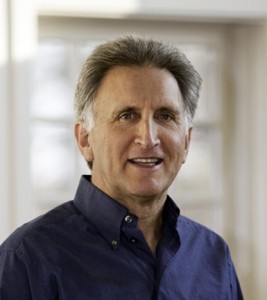
Andrew Goldstein, author of The Bookie's Son
I noted “Two Thumbs Enthusiastically Up!” in this review’s title. I have a new practice. If I receive a book to review and I really like it, I pass it on to my husband. He is a very bright, well-educated, and articulate man. (Of course he is, I married him.) He represents the market for the books I review. He loved this book. Listening to him laughing, practically rolling off the sofa, was delightful. [This is about to become a Three Thumbs Up! review. We handed the book to our daughter, who is reading it as enthusiastically as we did. This one's a winner!]
Mr. Goldstein, roll out your next work. We’re ready.
Reviewed by Sandy Nathan. I received a complementary copy to read and review.
May 4, 2012
What You Can Win by Losing: The 2012 IPPY (Independent Publisher) Awards Have Been Announced! Didn’t Win? Some Words to Cheer You Up

The Gold Medal in the IPPY Awards--So near, but so far
On May 2, 2012, awards for the last few categories of the 2012 IPPY (Independent Publisher) Awards were announced. Did your book receive an award?
Mine didn’t, either. I’ve been entering the IPPYs for years. This was the first time I didn’t win something. Kinda shocking.
It hurts to have your masterpiece spurned, but doesn’t hurt half as much as getting a one star review. That’s like a crossbow bolt to the heart, except you don’t get to die. You get to read those words savaging your beloved baby forever, or as long as your book’s Amazon page lasts. So losing in the IPPYs isn’t that bad.
You feel better already, don’t you?
This is an article about dealing with not winning a book contest. Usually I write about how to win book contests. One of the things I say in those articles is that you can do everything I say to do to win and still lose. I just demonstrated that.
Not winning in the 2012 IPPY (Independent Press) Awards brought to mind an actual event that happened to me in the olden days, before my body started disintegrating. I used to show horses. My family was into horses. That means: We’d blow the kids’ college tuition fund if a good show prospect came up. We were over-the-top, raving horse maniacs, like everyone else we knew. We bred, raised, trained and showed our horses, which were Peruvian Paso horses. That’s right, they originated in Peru. What follows is an uplifting to you (I hope), though extremely embarrassing to me, tale illustrating what can be learned through losing.
Hang in there: This is more of a short (or medium length) story, than a blog post. Actually, it’s a free Kindle short.
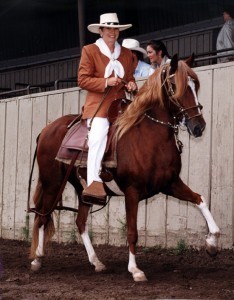
Azteca de Oro BSN & I at the Monterey show. This is NOT me riding Vistoso. I couldn't find a picture of the Big V and me. I'm riding Vistoso's full brother, Azteca, at the Monterey Fairgrounds. Close enough.
OK. I was riding one of our top horses, Vistoso, at the Mission Trails Classic Championship Peruvian Paso Horse Show in Monterey, CA. The Monterey show was very large and prestigious. All the top ranches attended the event; winning was a real coup.
Vistoso and I were in some class, most likely Performance Geldings, since he was a performance gelding. In performance classes, the horses don’t just zoom around the arena looking beautiful. They have to do something: stop and back up, go fast, go slow, turn in circles, reverse, and serpentine through poles set so close that the animals looked like snakes with manes and tails.
Vistoso and I were having the ride of a lifetime. We were on. We were in perfect harmony: a gorgeous young horse and an aging-but-still-pretty-together woman. Vistoso was a tall, bright chestnut gelding. He was big; he was bold. He was magnificent. (Which is what Vistoso means: Beautiful, delightful, showy, spectacular. Peruvian Paso horses are required to have Spanish names, in homage to their Peruvian roots.)
We moved around the carefully groomed arena. The stadium surrounding us was filled with everyone who wasn’t riding a horse or getting ready to. Vistoso didn’t take a false step the whole class. I could hear the four-beat sound of his gait, the paso llano, a slow gait particular to his breed. We were in perfect balance, horse and rider.
Other horses were in the arena, but I knew we had it nailed. We’d win the class, go on to the championship competition, and win that. From there, Vistoso would become the new Champion of Champions.

TWIGGY & LILY at Monterey–- This is my daughter Lily riding out of the arena on Twiggy, probably the hottest horse we've ever owned. Notice how the horse seems to be compressed horizontally, smashed from front to back. That's because she wants to leave the ring. If Lily let go of the reins, that horse would launch faster than something from Vandenburg Air Force Base.
The judge pointed to a number of horses moving along the rail, including Vistoso and me, and indicated that we should move to the center of the arena, next to the flapping canvas pavilion where the ring steward and officials sat with a pile of gaudy trophies. I eyed the trophies, panting slightly. We were in “the good pile.”
The judge then motioned to the horses still moving along the rail, indicating that they should leave the arena through the newly opened gates. They were “the bad pile.”
If you’re in the good pile, you’re that much closer to winning. Except that horses do not care about winning. They are herd animals: they care about being with their their buddies, who were leaving the arena. Horses in the good pile can become very anxious at this point.
The judge sent us to the far end of the arena and the announcer began calling out winners, working from the lowest place to the highest. A couple of honorable mentions. Fifth place. Fourth . . . When their numbers were announced, riders piloted their horses to the flapping pavilion and picked up their ribbons. They then left the arena, the horses practically bolting as they neared the open gates.
The higher your placement, the worse it gets. I was circling Vistoso at close to light speed as he became increasingly distressed watching his fellow equines escape. Finally, the Big V and I were the only horse/rider pair in the arena, except for this other woman on a little liver chestnut. (Yes, he was the color of liver.) I knew her. She was a really nice lady. Little horse. No sweat. The class was mine. I kept circling Vistoso, hoping that my triumph wouldn’t be overshadowed by him bucking me off. Then the announcer called the second place number.
It was MY number! I came in second. That was impossible. I had won the class. No one could have had a ride as good as ours. I rode out of the arena with my lousy red ribbon. I was pissed off, and I stayed that way the rest of the day, and into the night.
Evening fell, as it inevitably does. The big dinner dance was on. The Monterey fairgrounds have a really cool party set-up. Soft lights twinkled and the band struck up. A gorgeous buffet was laid out. Champagne flowed and folks in “Western/Peruvian formal” attire chatted it up or took to the dance floor.
I made my way through the crowd, turned a corner, and ran smack into the show’s judge. My eyes narrowed and my back went up.
The judge recognized me and put out her hand, grinning broadly. “Boy, did you ride that horse this afternoon!” Her praise was as heartfelt as any I’ve heard.
She didn’t fool me. That class was MINE. “Well, if you liked us so much, why didn’t you give us the blue ribbon?” I said. You see, I’m a liberated woman. I’ve also taken nine million assertiveness trainings. I was not about to let someone ***** me over.
The judge rocked back, and then replied without missing a beat. “Well, this is a very good show. A second prize in this show is equivalent to a championship somewhere else.”
I walked away, feeling slightly better and proud that I’d spoken up for myself. I was no wimp.
* * *
Fast forward to the end of the show season, late Fall. I’m at the Los Angeles Equestrian Center in Griffith Park, Los Angeles, CA. The National Championship Show for the Peruvian Paso breed is in full swing. This is the big, BIG time. Griffith Park is a real equestrian center. Massive cement grandstands circle an over-sized ring, creating a bowl which is spanned by a very high and equally massive ceiling.
The Nationals are like this: All the horses you’ve seen in the magazines are there with their famous trainers, equally famous ranch owners, and enough stable help to run a small resort. The barns where the horses are kept when not performing sport flags and banners and swags up and down the aisles. Each ranch has its signature colors. Videos advertising the ranches’ charms and horses for sale play at the end of each stall row. Multicolor ribbons flutter, too––whatever each ranch has won at the show is displayed front and center. Believe it or not, some ranches deck out their turf with potted palms and carpeting. It’s a spectacle that looks like it came out of George R.R. Martin’s Game of Thrones, but with more horses.
My nervous system goes into overload and then flames out with the tension of the Nationals. I’d already blown the classes I was riding in. “The bad pile” was probably above my head in that company. I had plenty of free time, so I sat in the stands, watching the show.
I jumped out of my seat when the woman who stole that class from me in Monterey rode through the gates. I leaned forward, teeth bared, a growl turning over in my throat. She was a petite, slender woman with rich dark hair. Her spine was erect, perfectly balanced as she sat the horse. Her stirrups were long, permitting her legs to extend downward gracefully. If you had dropped a line from the point of her knee, it would touch the tip of her toes. She held her hands low, almost touching the front of the saddle. Her equitation was plu-perfect.
Her horse, the grubby little thing I’d dismissed, wasn’t so grubby when I looked at him carefully. Liver chestnut is actually a rich medium brown, very correct and conservative. The horse was small and fine, elegant, like its rider. They were a brilliant match of type and style. Her poncho, saddle, bridle, everything, was exactly what the rule book specified. The animal moved along, relaxed, but alert, and precisely gaited.
Riding is one sport where the better you are, the less you do. You can see dressage riders in the Olympics whose horses are doing unbelievable things, but you can’t see the rider doing anything. The pair before me were like that. Exquisite. You know, there’s good riding, and then excellent riding. This was riding touched by angels.
I sat there, my mouth falling open. My hands went cold. I didn’t win that class in Monterey because I wasn’t good enough. I couldn’t see my competition because I was busy riding my own horse. Seeing her in that arena told me that she and that little gelding were world class. (In fact, they would win the National Champion of Champions Performance Gelding title later in the show.)
I had a sinking feeling when I realized what I’d done. I felt like my center of gravity was ten feet below the stadium and dropping. I remembered what I had said to that judge. My cheeks flamed. Embarrassment so powerful that you could almost see it washed over me. I had been so rude to that nice woman. I am still embarrassed about what I said, many years later.
I’ll never forget it.
* * *
So there it is: I didn’t win because I didn’t deserve to. I didn’t know I wasn’t the best because I was busy riding my own horse and couldn’t see the others.
* * *
Am I saying that your book didn’t win in the IPPYs because it wasn’t good enough? Well, . . .
Let’s take a look at that. When you enter your book in a contest, it’s like entering the arena on Vistoso that day in Monterey. You’re busy with your own entrant and can’t see the competition. You don’t know how good the other entrants’ books were. And you’ll never know. Remember me mouthing off to that judge when you feel like screaming over your placement. Don’t embarrass yourself.
Let’s look at book contests. You’ve zeroed out at the IPPYs this year. What should you do? Here are some options:
1. Walk away from it and never enter a book contest again. This is a pretty good option. Book contests are expensive. Aside from the cost of editing, proofreading, having my book designed and printed, along with the two years of my life I spent writing my book, Lady Grace, I forked out maybe $150 for the single category I entered. That includes the entry fee, postage, and materials for the press kit, which I included even though it wasn’t required. If I’d entered more categories or books, the cost would have multiplied.
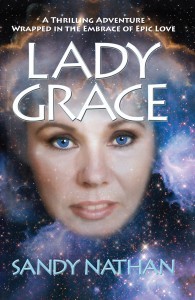
Lady Grace, my 2012 entry into the book contests. Finished moments before entries close,will the Lady have what it takes?
As an indie author, do you need awards from book contests to sell your book? Let’s look at some of the most successful authors––indie or traditional––of our time. Take John Locke, the first indie published author to sell one million ebooks. John’s probably about to hit the two million mark by now. What did that get him? A lot of money and a contract with Simon & Schuster, one that he designed that means his needs. (No yanking the indie author around.) And then we’ve got Amanda Hocking, who parlayed her young adult series into millions of book sales and dollars, and a contract with St. Martin’s Press. Darcie Chan, who published her book as an eBook after being rejected my the major publishers. She’s probably getting close to a million eBook sales by now and is a NYT Bestselling author, not to mention having a lot more loose change. What list of successful indies could leave out JA Konrath, the father of the “you can do better publishing it yourself” movement. Or M.J. Rose, probably the first author to go the self-pub route.
Did any of these people use awards from book contests for independent presses as their springboards to success? No. Did any of them enter such contests? Not that I know of.
(I don’t think they do blog tours, either.)
From these success stories, it looks like not entering book contests may increase your chances of success. Figuring out how to effectively sell your book is way to go.
2. Say you want to win prizes and enter more contests. What then? I’m like that. A compulsive competitor. I like to say, “Hi, I’m Sandy Nathan, award-winning author. I’ve won . . .” I like stickers and medals and certificates. I like to increase the number of wins I’ve got and post the new totals all over. Look at my website, for Pete’s sake. If that isn’t ever conspicuous flashing of glitz I don’t know what is.
My husband says, “Isn’t twenty-one awards enough?” I say, “No! A million wouldn’t be enough!”
You’re like me, you didn’t win the IPPYs this year, but you want to try again. Read the article below and follow it. This is my famous “What I do to win book contests” article. Do all that and enter your new book next year.
Or––take a look at your book and what you’re writing now. The IPPYs are a huge, prestigious contest, like the National Championships I described above. Are you up to that competition? If you don’t think you you can make it in the rarefied atmosphere of the IPPYs, pick a different contest. My article on how to win book contests has links to some very nice smaller contests. Maybe one is just perfect for your book.
3. If my recitation of what you actually get out of book contests sticks in your craw, pick a contest with really good prizes. Good prizes are a reason to compete even if you’re horrified by what I’ve said above. I’m sharing a secret now. The 2012 National Indie Excellence Contest has killer prizes. Check ‘em out on their web site. They have regular winner and finalist prizes for the various categories, but the overall winners get stuff like thousands of dollars of services from top publicists. That’s worth competing for. It’s too late to enter this year, but 2013 is coming fast.

The Angel & the Brown-eyed Boy––Winner of the 2011 Gold Medal for Visionary Fiction in the IPPY Awards
4. What does winning really mean? In 2011, I was thrilled and delighted when my book The Angel & the Brown-eyed Boy won the Gold Medal in Visionary Fiction at the IPPYs. I’d won in previous IPPYs, but never a Gold. I feel tremendous gratitude to the people putting on the contest for acknowledging my book as they did.
The Angel & the Brown-eyed Boy is Book I of Tales from Earth’s End. The series is a fantasy/sci-fi/visionary fiction tale about people pushed to the literal ends of the earth. In The Angel, nuclear holocaust looms as the characters work to mend their past “business” and figure out how to survive the destruction of the planet. The Angel is a good book. It’s an important book treating the possibility of nuclear weapons destroying our world, as well as what can come from an economic disaster which is not successfully resolved. It’s beautifully produced and has a killer cover. I like this book very much.
Lady Grace is the second book in the Tales from Earth’s End series and was my entry in the 2012 IPPY Awards. Lady Grace sets out what happens to a small group of survivors of the nuclear war as they begin to create a new world. Every book professional who has touched Lady Grace has told me that it’s not just better than The Angel, it’s way better. “Your pacing, the plotting, the characters––all are terrific. This is the best writing you’ve done.” That was my editor. Others have said the same sort of thing: I’ve hit my stride with Lady Grace. I knew it, too.
A woman in my book club who told me she’d hated everything I’ve written called me babbling in rapture after reading Lady Grace. “It’s fantastic, Sandy. It’s the best book I’ve ever read. How did you do that? Where did you come up with all that?” And more, she went on and on. I loved it.

Lady Grace, my 2012 entry into the book contests. Finished moments before entries closed, Lady Grace was left in the paddock area at the end of the race.
OK. The Angel won the Visionary Fiction category in 2011, for which I will be eternally grateful. Lady Grace didn’t win anything in 2012, but it’s a better book in every way. Except maybe its cover. The version I submitted was straight off the presses; it might have been a proof. We got print copies of the book in that close to the contest’s deadline.
The final issue I’m raising is about judging. I’m not doing the snotty thing that I did to that poor judge in Monterey. I realize that the emerging National Champion of Champions might have been entered in the Visionary Fiction category in 2012. I don’t know what the competition was, or what the competition was in 2011 when The Angel won the Gold.
It’s just really weird to me that a lesser book should win the competition and a superior one not even place. Did the judges read it? Maybe totally different judges were working in 2012, and they had different preferences. You see that showing horses all the time. Some judges hate a particular type, while others love it. Maybe the fact that the cover wasn’t totally jelled knocked it out. That’s possible. We’ve since modified the cover, cleaning up the colors and changing the tag line.
A lot of things could have happened, and some of them must have.
What does the judging mean? What do you win when you win? Are the winners really the best books? What does an award mean?
The more I think on these things, the more I tend to agree with my husband. Maybe twenty-one awards is enough.
So, campers, we’ve finished our romp through Contestland. I don’t know if I made you feel any better after your non-award, but maybe I made you more thoughtful.
I look forward to hearing from others about their contest experiences. Would you do it again? What did it do for book sales? Your career?
Let me know, folks.

Sandy Nathan is the winner of twenty-one national awards for her writing. She’s won in categories from memoir, to visionary fiction, to children’s nonfiction. And more.
Sandy’s books are: (Click link to the left for more information on each book. All links below go to Kindle sale pages.)
Sam & Emily: A Love Story from the Underground (paperback. Kindle coming)
Lady Grace: A Thrilling Adventure Wrapped in the Embrace of Epic Love (paperback. Kindle coming)
The Angel & the Brown-eyed Boy
Numenon: A Tale of Mysticism & Money
Tecolote: The Little Horse That Could
Stepping Off the Edge: Learning & Living Spiritual Practice








